Biotechnology: Senior Capstone Projects
Students in the KU School of Professional Studies biotechnology program conduct a senior capstone project that challenges them to apply their technical and research skills gained through their studies. Read below to learn more about the Biotechnology students’ capstone projects.
Industry Sponsors


![]()

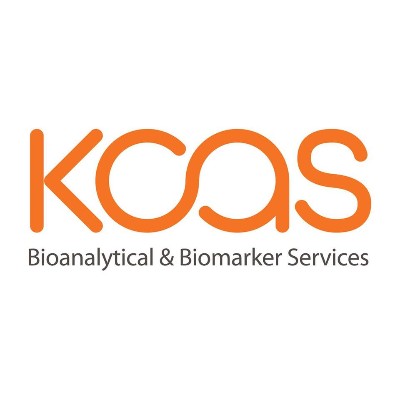
Biotech Seniors 2024-2025
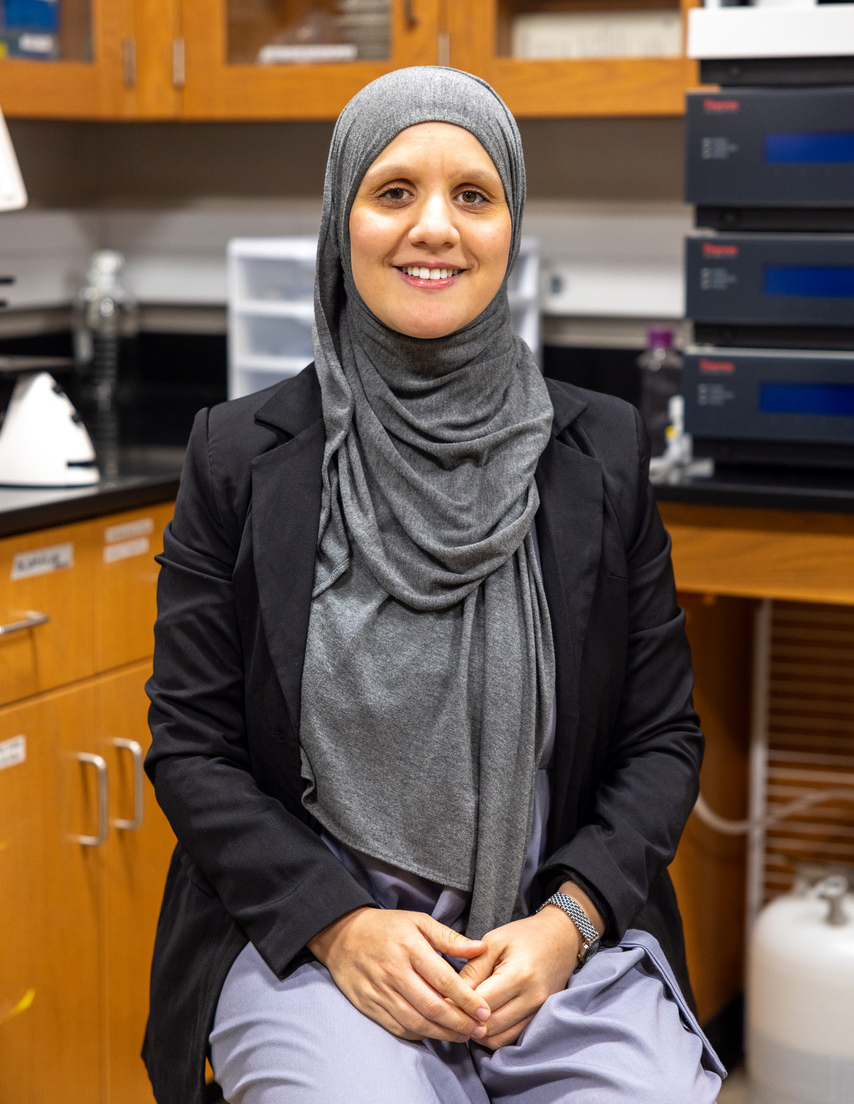
Samia Chergui
Treatment of Dental Infection: Periimplantitis? Peptides Say No!
Peri-implantitis is a major challenge in modern dentistry, posing a significant threat to the long- term success of dental implants. This inflammatory condition, characterized by the loss of supporting bone around a dental implant due to infection, can lead to implant failure if left untreated. However, broad spectrum antibiotic treatment, even if only locally applied, could lead to an imbalance in normal oral microbiota. Understanding the specific identity of the pathogens involved in peri-implantitis and their susceptibility to treatment is crucial for developing effective prevention and management strategies. One potential solution lies in the utilization of antimicrobial peptides (AMPs), which are natural components of the innate immune system. AMPs can exhibit both broad-spectrum and targeted antimicrobial activity and have been studied for their potential in combating various microbial infections, including those associated with peri-implantitis. This research project focuses on developing novel AMPs specifically targeting Streptococcus gordonii, a common oral bacterium capable of forming biofilms on dental implant surfaces and contributing to the pathogenesis of peri-implantitis. By employing recombinant DNA techniques, we aim to engineer AMPs that can effectively clear these pathogens while sparing other oral microbiota.
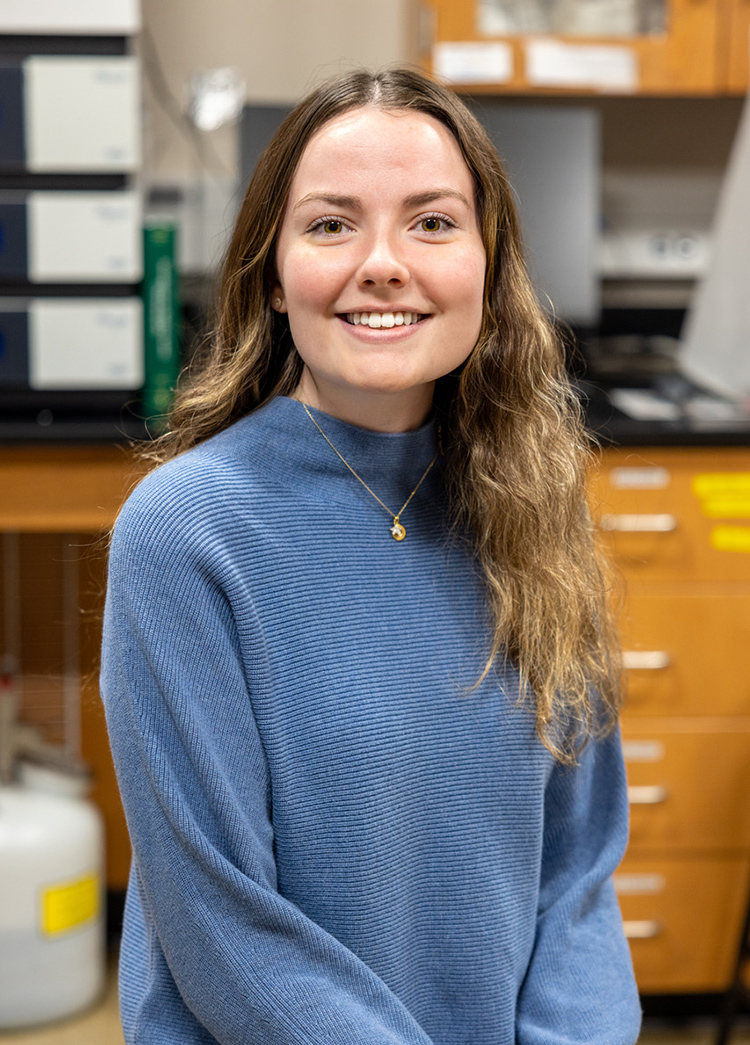
Danielle Jardine
Environmental Impacts, Pulmonology: Non-Stick Coating-Good for your Pansa; Not for your Lungs
Per- and PolyFluoroAlkyl Substances (PFAS) are a group of synthetic chemicals designed to resist water, grease, and heat. They are commonly used in non-stick cookware, clothes, food packaging, and adhesives. Because they don’t readily break down in the environment, they are nicknamed “forever chemicals.” Aside from environmental pollution, they are increasingly found in our bodies, impacting our health, including respiratory issues such as asthma, impaired lung function, and reduced lung surfactant function. Lung surfactants form thin film of lipids and proteins that reduce surface tension in the alveoli allowing for flexibility and preventing internal adhesion which would result in lung collapse upon exhalation. This study investigates the interaction between forever chemicals and lung surfactants, specifically as they relate to compression and expansion of alveoli-modeling surfaces. Tests will be run to note the change in surface tension and pressure between the different cycles to model breathing with and without PFAS exposure. Oscillation experiments will measure the viscosity and elasticity of the surfaces to determine their ability to return to their unstressed state. The findings will highlight the effects of PFAS compounds as these pollutants contribute to respiratory ailments.

Lina Kassahun
Environmental Impacts, Fauna: Detangling the Toxic Thread
Perfluorohexane sulfonate (PFHxS) is a short-chain per- and polyfluoroalkyl substance (PFAS) increasingly used in consumer products, including dental floss. Due to its potential to accumulate in the body, assessing the effects of PFHxS in a model biological system is crucial to understanding its potential for health impacts in humans. This study aims to investigate the exposure and effects of PFHxS on Caenorhabditis elegans, a model organism widely used in biological research. In this study, we will estimate exposure by quantifying the amount of PFHxS leached from dental floss in a mouth-simulating apparatus. C. elegans larvae will be exposed to varying concentrations of PFHxS, ranging from 1 nM to 1 μM, within 12 hours post-fertilization over a 72-hour period. We will assess the impacts of PFHxS on survival rates, growth, and organogenesis. Additionally, gene expression analysis of the sod-3 and daf-2 genes will be performed to evaluate oxidative stress levels and the potential effects on the endocrine system and obesity-related pathways, given the known impacts of PFAS on these systems. Our findings are expected to indicate that PFHxS exposure, even at low concentrations, may adversely effects development and cellular function. Considering the use of PFHxS in products like dental floss and its potential for ingestion, this study aims to provide evidence that PFHxS-containing products could pose health risks to humans with prolonged exposure.
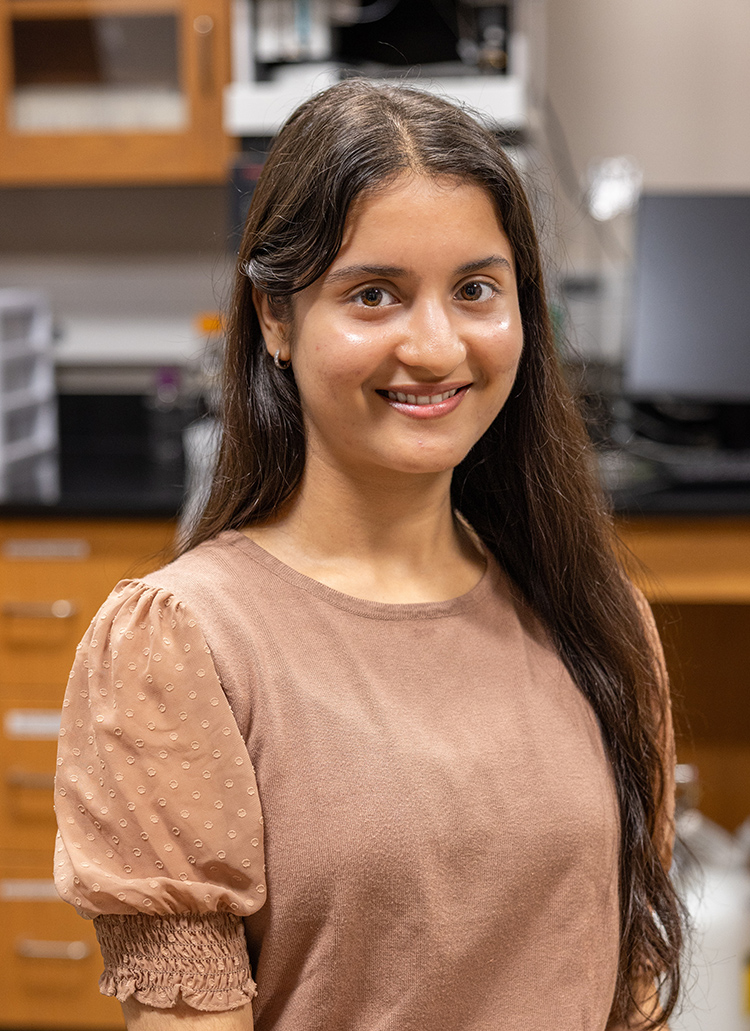
Kuljeet Kaur
Natural Therapeutics, Flora: Turmeric-From Kitchen Spice to Cancer Fighter
Colorectal cancer (CRC) is one of the leading causes of cancer-related deaths worldwide. This cancer typically develops from benign polyps in the colon and rectum that may become malignant if untreated. Current standard CRC treatments like surgery, chemotherapy, and radiation, can be effective but often have serious side effects that impact patient quality of life. This challenge has led to interest in natural compounds like curcumin, which may offer therapeutic benefits with potentially fewer side effects. Curcumin, the main active compound in turmeric, has shown promising anti-inflammatory, antioxidant, and anticancer effects in previous scientific research, suggesting its potential as an adjunct therapy for CRC. This study investigates curcumin’s effects on CRC by treating HCT116 colorectal cancer cells and normal cells with varying concentrations of curcumin. Toxicity and morphological changes will be assessed using a Trypan Blue cell viability assay and microscopy to identify concentrations that effectively reduce cancer cell viability while sparing healthy cells. By assessing curcumin's impact at varying concentrations, this research seeks to determine curcumin’s therapeutic range and potential as a therapeutic agent. The findings may contribute to understanding how curcumin could be integrated into colorectal cancer treatment strategies, offering a natural, potentially less toxic complement to existing therapies.

Soham Kawade
Environmental Impacts, Flora: Lipid Peroxidation in Response to Environmental Stressors
Lipid peroxidation is a key indicator of oxidative stress in plants, occurring when environmental stressors such as pollution, drought, and extreme temperatures trigger the overproduction of reactive oxygen species (ROS), leading to the degradation of cellular membranes. This study investigates lipid peroxidation as a biochemical marker to assess plant health under stress due to heavy metal content in the soil and drought to explores how it may serve as a "silent signal" of environmental stressors. Using the Thiobarbituric Acid Reactive Substances (TBARS) assay, lipid peroxidation levels will be quantified by measuring malondialdehyde (MDA), a byproduct of oxidative damage to lipids. Additionally, plant antioxidant responses will be analyzed to determine how effectively plants counteract oxidative stress. Antioxidant enzyme activities, including those of superoxide dismutase (SOD), catalase (CAT), and peroxidase (POD), will be measured to gauge the plant’s defense mechanisms. The results are expected to reveal any correlation between elevated environmental stress and increased lipid peroxidation to assess its reliability as a biomarker for environmental damage. This research offers valuable implications for monitoring ecosystem health and improving agricultural practices under changing environmental conditions.
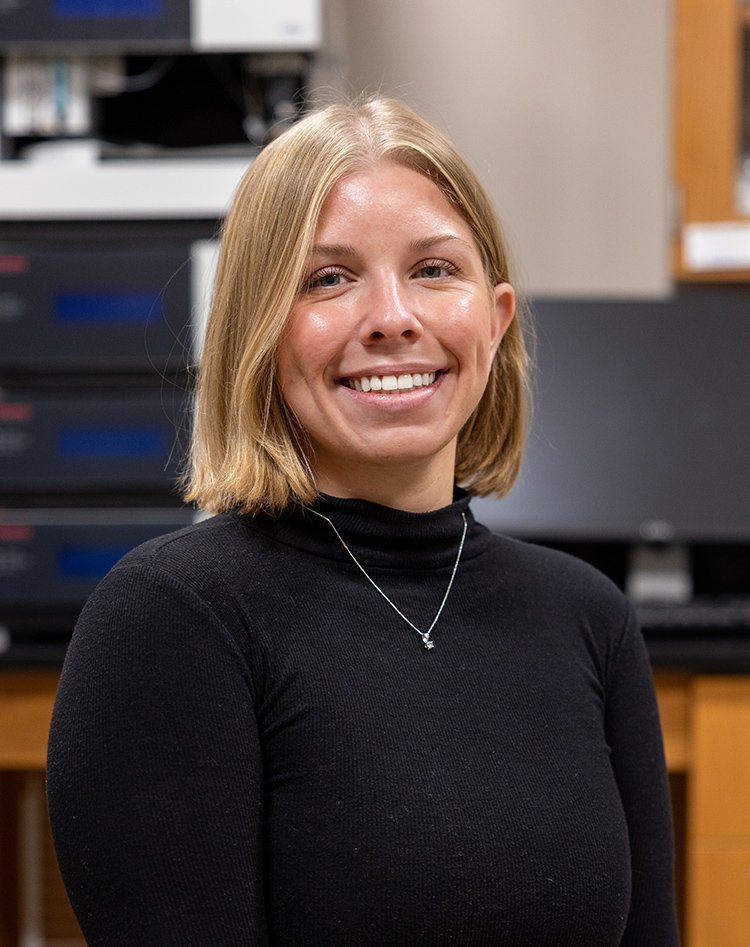
Isabella Press
Veterinary Health: A Diet to Reduce Chronic Inflammation?
The ketone body ß-hydroxybutyrate (BHB) supports mammalian survival during states of energy deficit and serves as an alternative source of ATP is elevated during starvation, caloric restriction, high-intensity exercise, or low-carbohydrate ketogenic diets. Prolonged fasting or ketogenic diets which elevate BHB have also been shown to reduce inflammation in both human and mouse models. BHB is suspected of suppressing the activation of the NLRP3 inflammasome and subsequently reducing NLRP3 inflammasome-mediated secretion of IL- 1ß and IL-18, cytokines that lead to chronic inflammation. Mechanistically, it is known that BHB inhibits the NLRP3 inflammasome by preventing K+ efflux and reducing ASC oligomerization and speck formation in mouse models. However, little is known about whether BHB inhibits NLRP3 mediated production of IL-1ß and IL-18 in canine models. The current work will assess whether BHB is capable of inhibiting NLRP3 mediated production of IL-1ß and IL-18 in a canine model to assess the potential for a therapeutic application of ketogenic diets to treat canine inflammatory diseases related to the NLRP3 inflammasome.
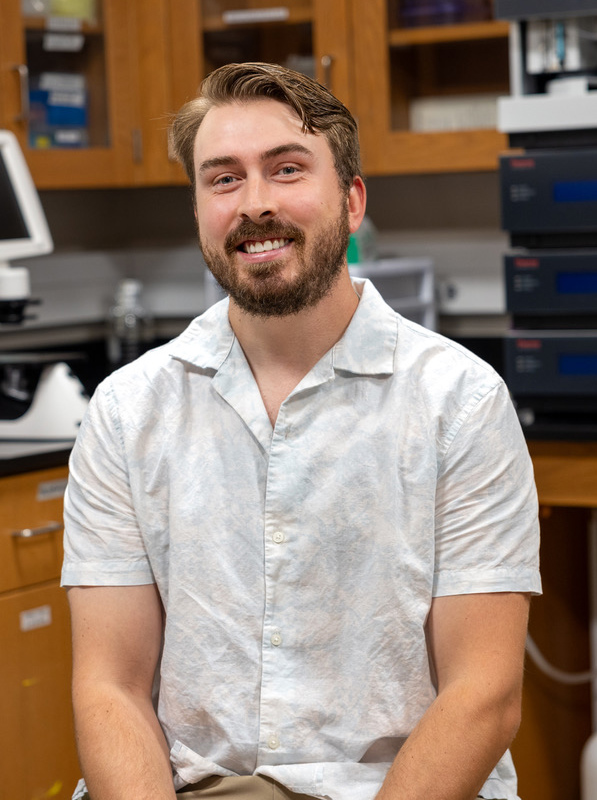
Alex Rees
Environmental Impact, Microplastic: Turning Trash into Triumph
Since the first plastics were commercially introduced in 1871, there has been an astronomical rise in its use. PET plastic (polyethylene terephthalate) was first polymerized in the 1940s by DuPont as a textile fibers. Because these compounds are relatively new, man-made creations, there are no preexisting pathways for them to biodegrade. This had led to a crisis in plastic accumulation in the environment, where products mechanically break down into small pieces called microplastics and nanoplastics. These small fragments are found in virtually every environmental niche around the world including inside humans and other animals, with research linking them to cancer, cell damage, and cardiovascular issues. A bacteria strain called Ideonella sakaiensis, found in Osaka, Japan in 2016, was discovered to produce an enzyme called PETase that is able to break down plastics enzymatically, into compounds the bacteria can eat. This enzyme represents the best biological method to recycle plastic but issues remain trying to bring this method to the scale required to solve the plastic pollution crisis. This research aims to clone the DNA that makes this enzyme into E. coli and the microalgae species, Spirulina, to make these organisms capable of digesting the PET plastics. PETase activity will be measured via high performance liquid chromatography by the amount of the breakdown product, terephthalic acid. This research will assess the potential for a microbial-based biological recycling program that could be released in the wild.
Biotech Seniors 2023-2024
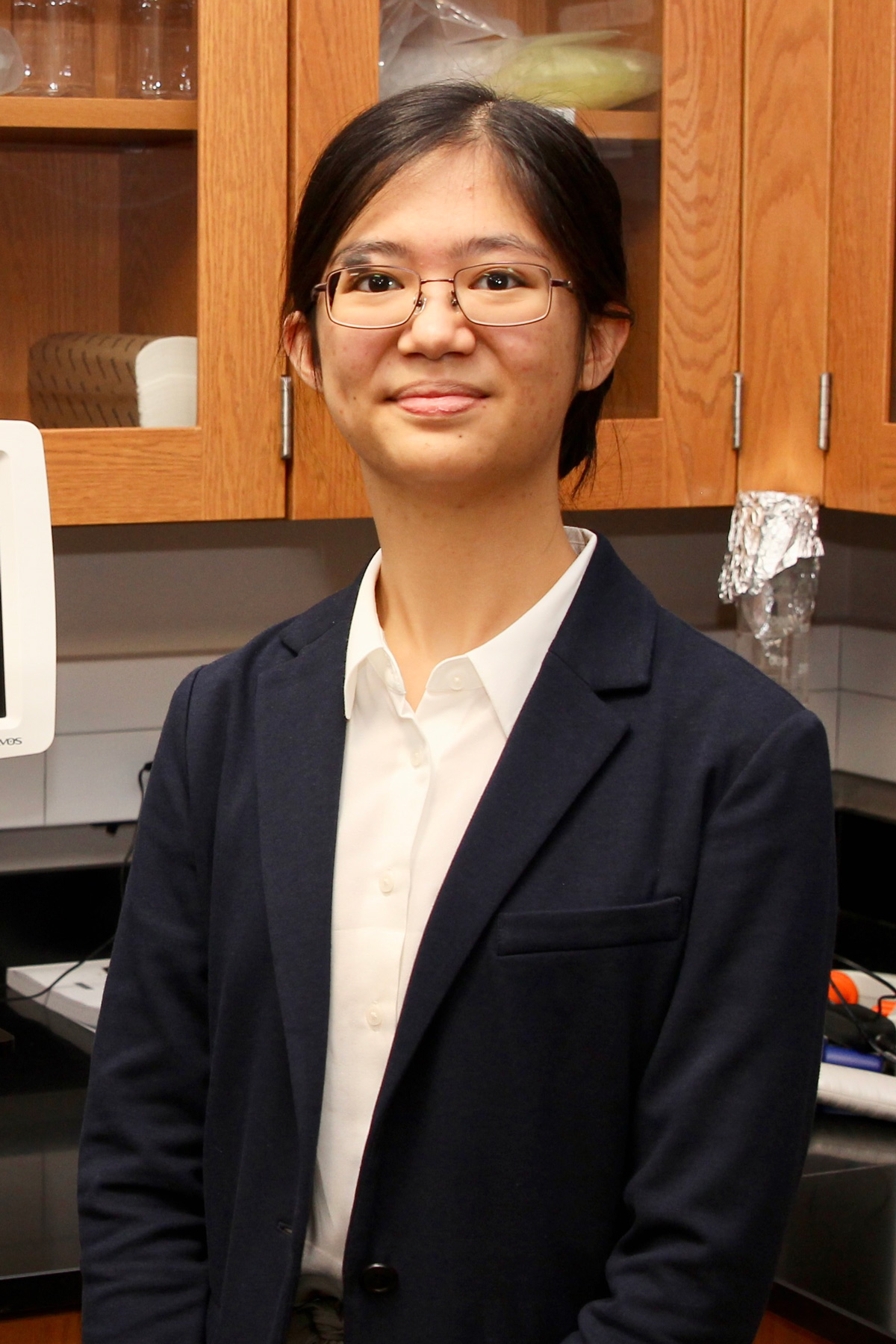
Kaitlyn Sy
Cell Signaling: Is lactic acid in the tumor microenvironment acting as an invisibility cloak for cancer?
Cancer is a devastating genetic disease caused by the uncontrolled proliferation of abnormal cells. Approximately one in every three individuals will be diagnosed with cancer at some point in their lifetime. Scientists have been hard at work to understand how cancer gains a foothold in its victim’s body and how this can be disrupted or prevented to stop the cancer’s progression. Specifically, a hot topic in cancer research has been how cancer hides from the immune system. Normally, CD8+ T cells patrol the body in search of diseased cells to target and destroy. If CD8+ T cells can clear diseased cells, then how do cancer cells survive and proliferate? Recently, scientists found a possible explanation. Tumors tend to have poor blood supply and consequently have low oxygen supply. Without sufficient oxygen, cancer cells shift their metabolism to anaerobic respiration to keep up with the energy demands of their rapid proliferation. This results in the buildup of the metabolic byproduct lactic acid in the area surrounding the tumor—called the tumor microenvironment—which may act as an invisibility cloak for the cancer cells. The goal of the present study is to assess the effects of high concentrations of lactic acid in the tumor microenvironment on the viability and responsiveness of CD8+ T cells. The findings of this study may provide insights into future approaches to cancer treatment and ultimately lead to better outcomes for cancer patients.
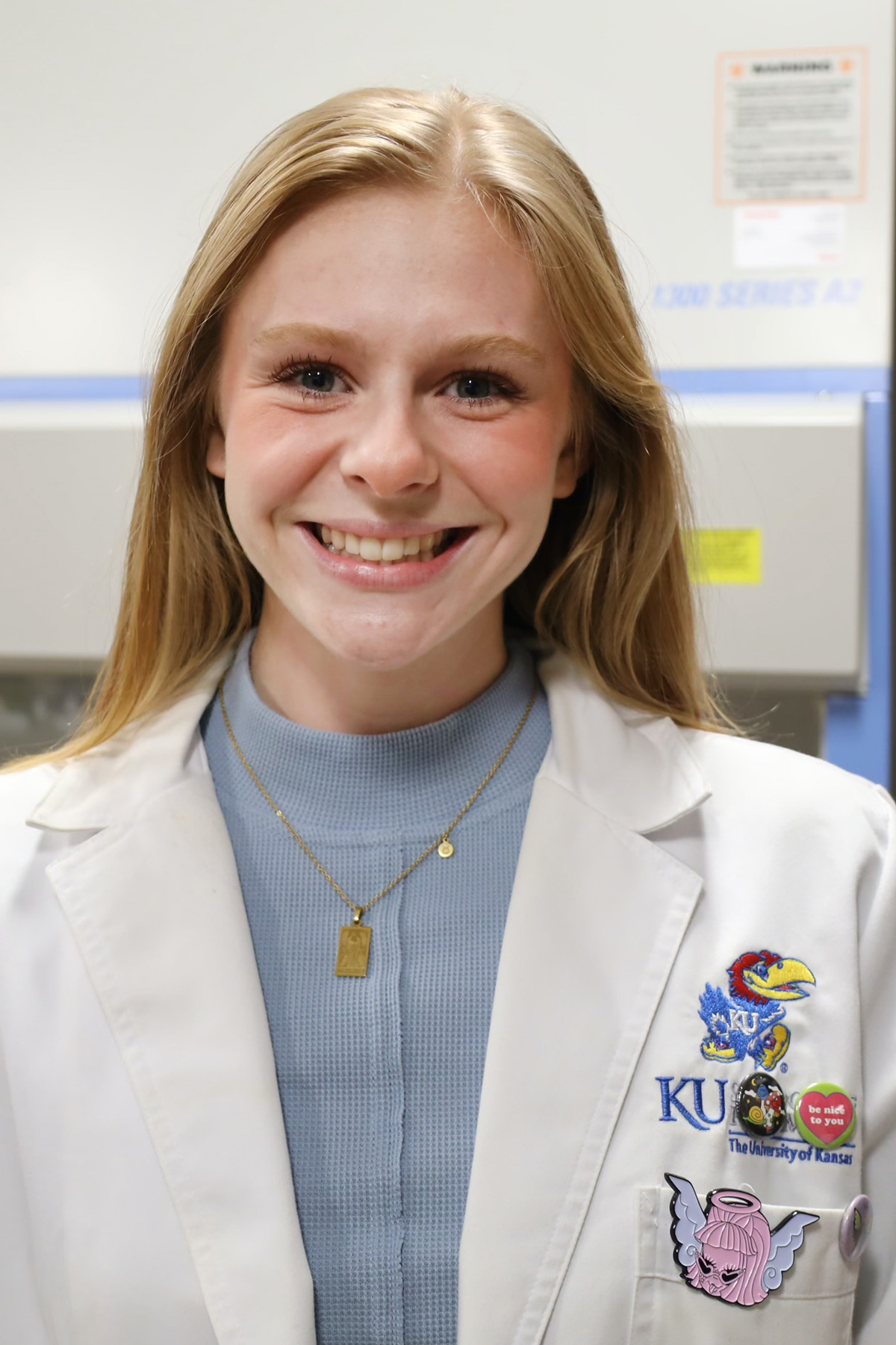
Bridget Ruhme
Recombinant Protein Production: Revolutionizing Textile Dyeing by Exploiting Nature’s Palette of Endogenous Beet Pigments
The textile industry contributes a substantial amount of environmental pollution in the form of synthetic azo dyes. These dyes are long-lived chemicals that are photolytically stable and include some mutagenic and carcinogenic properties. Innovative alternatives to these synthetic dyes could minimize the negative ecological impact of the textile industry. Dyes may also contain heavy metals such as lead or cadmium, which are used as catalysts in their synthesis but are hazardous when concentrated or in close contact with the skin. This research project is focused on developing a bioengineered strain of yeast that can be used to manufacture biosynthetic red and yellow pigments derived from genes extracted from beetroot. These biosynthetic dyes will be purified, and their fabric-staining properties will be characterized. This research will serve as a proof-of-concept study that could lay the foundation for a future where fashionable clothing and environmental responsibility seamlessly coexist.

Olive Njoroge
Cell Biology: Modeling Keloid-Prone Fibroblasts for Therapeutic Exploration
Wound healing is a process our bodies undergo to prevent infection and rebuild the skin’s barrier defenses. Scar formation is typically dependent upon the severity and complexity of an injury; however some people are prone to keloid scar formation. Keloids are a type of abnormal scar tissue that grows outside of the boundary of the original wound. In the wound healing process, fibroblasts are responsible for secreting collagen to rebuild the skin and fill in where it was disrupted. In keloid formation, fibroblasts produce excess collagen, leading to the appearance of a raised, overgrown scar. Collagen type I is a protein encoded by COL1A1, one of the main components of keloids. Modulating COL1A1 expression by fibroblasts could serve as a model for wound healing in which the over-abundance of collagen could be interrogated in isolation. This model could contribute to a better understanding of the mechanisms underlying keloid development and lead to a model for therapeutic targeting of collagen.
Biotech Seniors 2022-2023

Cinthia Moncada
Can Ginseng Help Fight Breast Cancer?
Breast cancer is a global health concern. In the United States, breast cancer is one of the most common cancers in women. Although treatments exist, many are associated with harmful side effects, resulting in a persisting need for novel, less toxic treatments. One such prospect is ginseng, which literature suggests has anticancer properties and may upregulate the tumor suppressor protein, p53. This protein regulates the expression of other genes, some of which arrest cell cycle. Specifically, p53 induces p21, which is a cyclin/CDK inhibitor without which, cells cannot progress through the cell cycle. My research seeks to assess the anticancer effects of ginseng on the MCF-7 breast cancer cell. Several questions will be explored, including what concentration of ginseng can be used on MCF-7 cells without toxicity, whether/how ginseng influences the expression of p53 and p21, and if cell cycle arrest occurs following treatment with ginseng. Cytotoxicity will be determined by an MTT assay, while RT-PCR will be used to determine mRNA production to examine the regulation of p53 and p21 genes. Lastly, flow cytometry will be used to determine if and when cell cycle arrest results from ginseng treatment. Altogether, this research explores whether ginseng may be an adjunctive or alternative treatment for breast cancer.
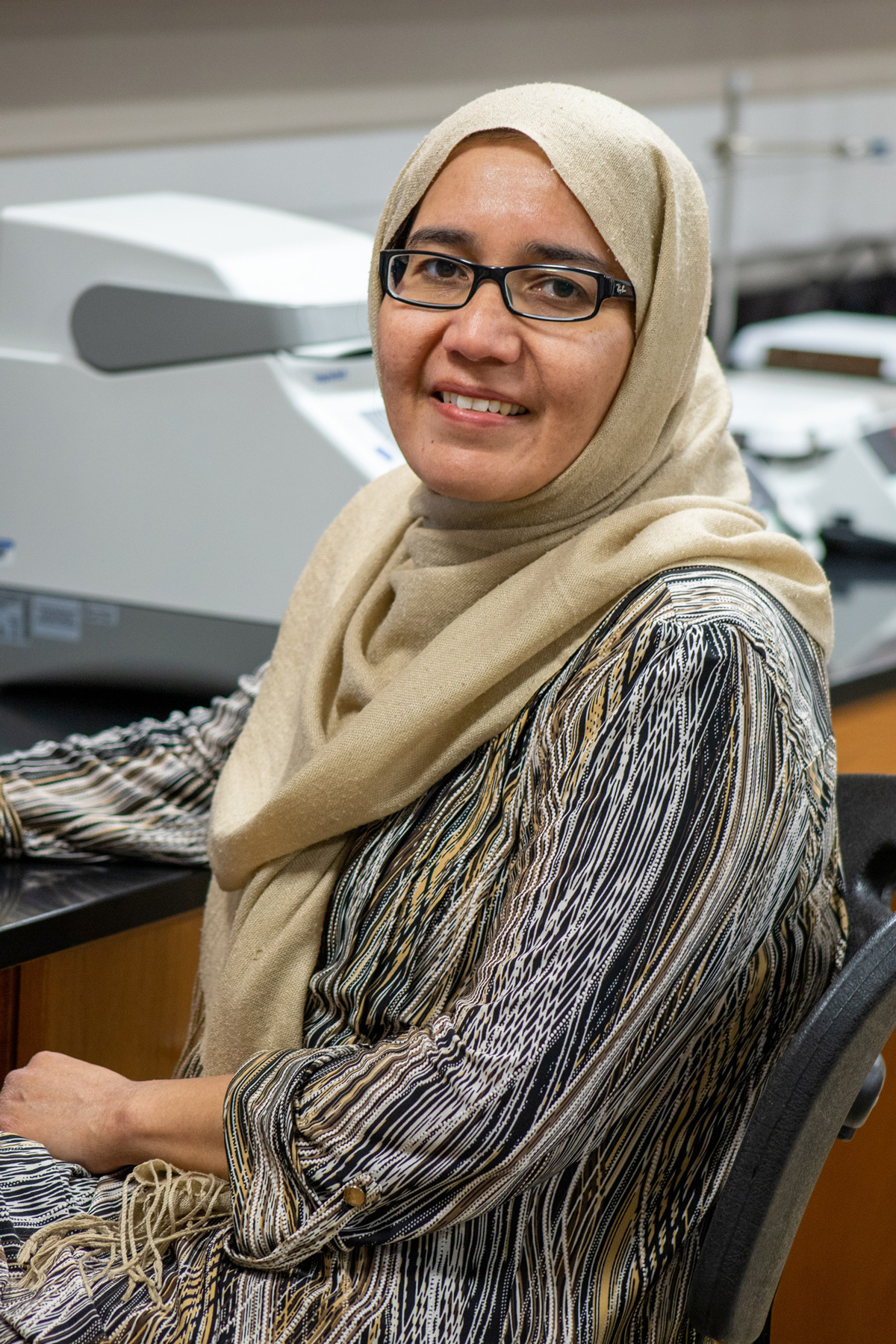
Ambreen Niaman
Analysis of Antioxidant and Antimutagenic Effect of Chlorogenic Acid, a Component in Coffee
The coffee plant was discovered in Ethiopia by a goat herder named “Kalidi” around 850 AD. He observed increased physical activity in goats after they consumed the beans of the plant. Since that time, coffee has become an everyday staple of life around the globe. While caffeine is responsible for much of the effects of coffee, chlorogenic acid (CGA), a polyphenolic compound in coffee, is an ester of quinic acid and caffeic acid believed to have antioxidant properties. One benefit of antioxidants is their ability to block mutations in healthy cells caused by free radical attacks. In this project, several questions will be explored regarding CGA, including what concentration of CGA is in commercially available coffee, whether CGA does exhibit antioxidant properties, and if it can block DNA mutation in bacteria. CGA will be quantified by HPLC (High-Performance Liquid Chromatography). The antioxidant activity of chlorogenic acid will be characterized in vitro by its ability to neutralize free radicals in a colorimetric assay and an Ames test will be used to measure its potential to block mutation in bacteria caused by a known mutagen. Overall, the results of this research project will contribute to our understanding of CGA as an antioxidant and its potential use as an antimutagen therapeutic.

Hazel Hernandez
Can Beta-Blockers be Used as an Alternative Treatment for Cancer?
Our body goes through a process in which cells grow and multiply as needed. When a cell becomes old or damaged, the cell dies and is replaced by a new cell. When this process is disrupted, abnormal or damaged cells can multiply into tumors. Catecholamines like norepinephrine and epinephrine are known to increase the proliferation of cancer cells. These molecules act as neurotransmitters and hormones in charge of the fight or flight by binding to beta(-adrenergic) receptors in our body's various cell types, including cancer cells. Beta-blockers are medications generally used to reduce blood pressure by binding to beta-receptors. This project aims to explore beta-blockers as a possible treatment for cancer using MCF-7 breast cancer cells as a model. MCF-7 cells will be grown in culture and treated with epinephrine. A cell growth assay will determine what epinephrine concentrations may increase the proliferation of cancer cells. A similar assay will then be used to assess the capacity for beta-blockers to interrupt normal or catecholamine-induced cell growth. Overall, the results of this research project will contribute to our understanding of neuroimmune crosstalk in cancer and the potential use of beta-blockers as anticancer therapeutics.
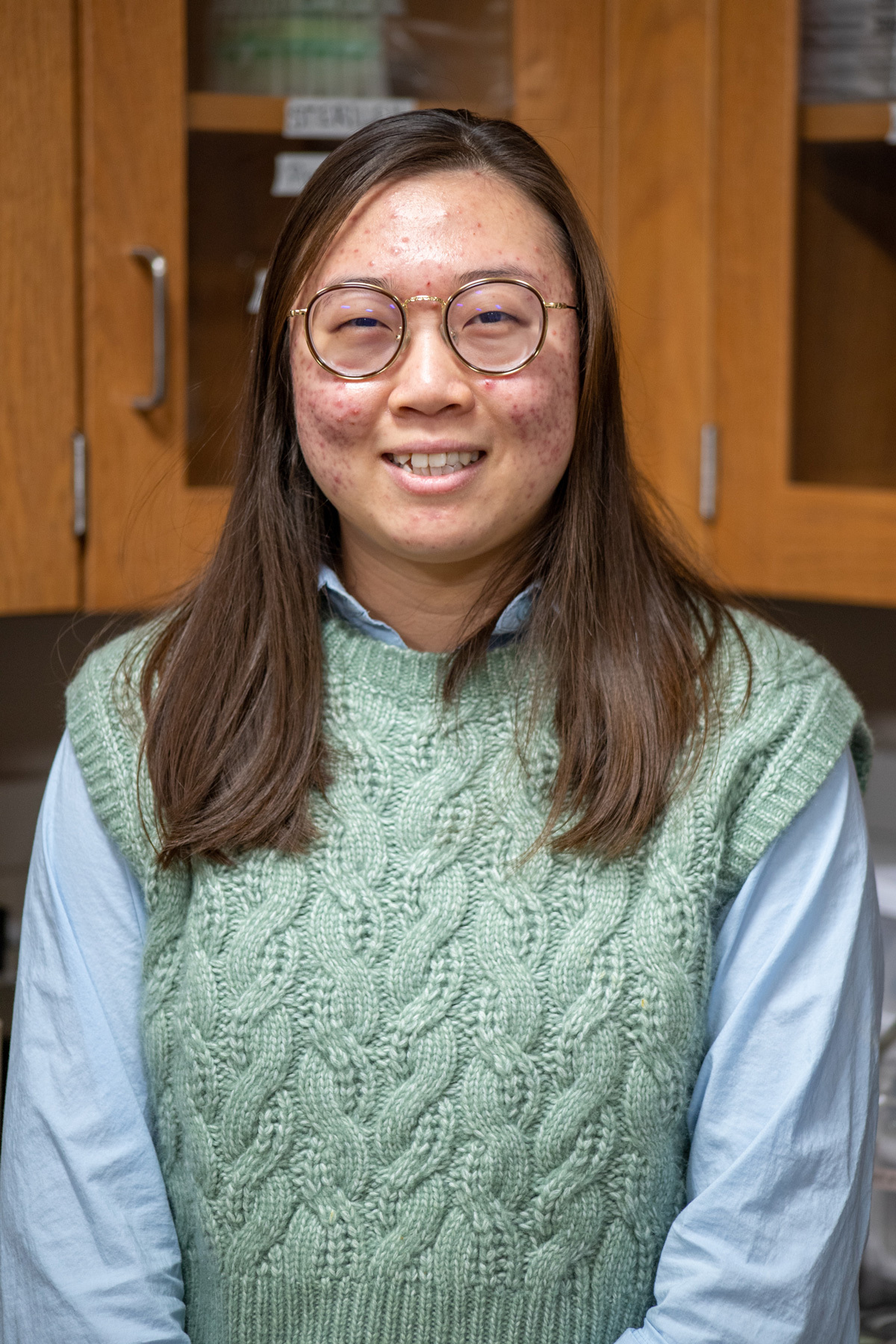
Jing Wong
Analyzing Jurkat T Cell Proliferation in an Adenosine-rich Microenvironment
The immune system is most commonly thought of for its role in protecting the body from invading microbes, however, it is also critical for preventing cancer. Specifically, lymphocytes such as NK and T Cells are required for this function.
Adenosine is a widely known byproduct of energy consumption by the body's cells. Extracellular adenosine is formed as a result of the hydrolysis of adenosine triphosphate (ATP) and adenosine diphosphate (ADP) to adenosine monophosphate (AMP) by the transmembrane proteins, CD39 and CD73, which are broadly expressed on immune and tumor cells. Additionally, immune cells have been shown to express G-protein-coupled adenosine receptors (AR) such as the A2A adenosine receptor (A2AR) found on T cells. These receptors have been suggested to impart immunosuppressive signaling to the T cells, which protects inflamed tissues from excessive damage by these cells. Interestingly, ATP is often released from dying tumor cells into the microenvironment around the tumor as a result of the attack of T cells.
In order for T cells to keep up with growing tumors, they must proliferate multiple times during an immune reaction to increase their number. However, the more tumor cells they kill, the more ATP accumulates in the tumor microenvironment, leading to adenosine production by the CD39 and CD73. The effect this excessive adenosine accumulation in the tumor microenvironment has on T cell proliferation is not well known. To examine the qualitative change in T cells in the presence of adenosine, Jurkat T cells will be used as a model cell line to evaluate the proliferation, viability, and survival of T cells that are susceptible to A2AR agonists. Understanding the immune responses of T cells when exposed to an adenosine-rich microenvironment could be an important breakthrough in discovering potential therapeutic targets in oncology regarding A2AR as a receptor of interest for new drug development.
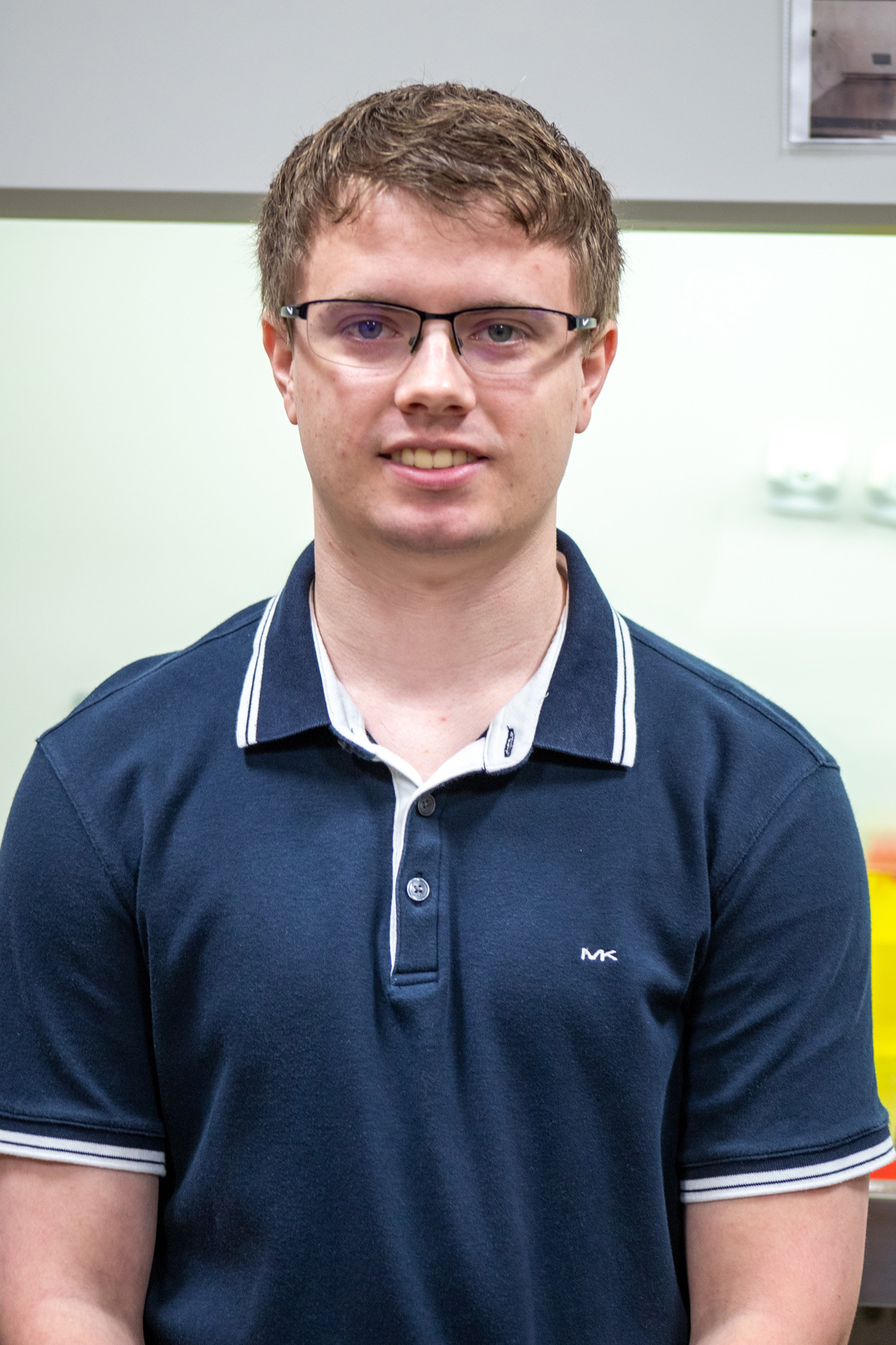
Alex Sage
How IL-37, a Regulator of Immunity, is Regulated
Inflammation is a common, normal immune response exhibited by the body to protect against pathogens, chemicals, and other hazards. This response is characterized by heat, redness, swelling, loss of function, and/or pain in the affected area. Chronic inflammation occurs when these symptoms persist. Rarely does a person live their entire life without experiencing inflammation and less often do our pets. As much as thirty percent of Americans will be diagnosed as obese or overweight in their lifetimes, however as much as fifty percent of all dogs will be diagnosed as obese or overweight, putting them at a greater risk of developing a chronic inflammatory condition. While there are many ways for treating inflammation, there is still much that we do not understand in terms of the mechanisms behind how our bodies manage inflammation. A recently discovered protein, IL-37, has been shown to exhibit anti-inflammatory properties suggesting that it may regulate this condition. This research project aims to characterize the expression of IL-37 in DH82 cells under various inflammatory and anti-inflammatory conditions. The concentrations of extracellular IL-37 (in cell culture media) and intracellular protein (from cell lysates) will be measured via ELISA. Additionally, RT-PCR will be performed to assess the production of new material by the cell. These results will provide much needed information related to the mechanisms behind the regulated expression of IL-37.

Guenaele Raphael
Can the Optimization of Cell Culture Media Increase the Production of Recombinant Proteins in the Baculovirus/Expression System?
The baculovirus expression system (BEVS) has been at the forefront of pharmaceutical and biotechnological research and has served as a tool to produce several human therapeutics such as Cervavix ® (preventative vaccine against the Human Papilloma Virus), Flublok ® (preventative vaccine against seasonal influenza virus) and Glybera ® (gene therapy treatment for lipoprotein lipase deficiency). This protein expression platform offers many advantages including flexibility in product design, high levels of protein expression and post-translational modifications, as well as scalability in manufacturing. Despite these advantages, the use of BEVS to produce recombinant proteins remains costly and time-consuming. Therefore, efficient and robust methods to improve the production processes of recombinant proteins in this expression system are necessary to respond to large-scale manufacturing needs. There is emerging evidence that baculovirus infections induce apoptosis of insect cells leading to lower protein yields. Previous research has also demonstrated that the optimization of cell culture parameters, media components, and feed strategies aid in obtaining high-density cultures resulting in higher yields of recombinant proteins in this system. This research project will examine the effects of two macromolecules (glucose, and glutathione) as potential cell culture media additives to increase the yield of recombinant proteins in the baculovirus/insect cell expression system. Protein production will be analyzed via ELISA and/or Western Blot. This project will also develop a rapid fluorescence assay via GFP as a surrogate for the detection of target proteins.

Marissa Gaffen
Natural Antioxidant-Rich Foods Stabilizers of Forensic DNA Samples
Wherever there are people, there is crime. Violent crime, particularly, leaves inexorable marks on society. Yet there are thousands of cases that remain unsolved. Most of these cold cases persist because of the lack of DNA evidence. At a crime scene, DNA is exposed to a variety of destabilizing conditions. A primary, ubiquitous destabilizer is sunlight. This occurs because UV radiation creates free radicals capable of oxidizing DNA. Once oxidized, the covalent bonds of DNA may be disrupted and thymine dimers may form, both of which make it unsuitable for use as evidence. Mint is abundant, cheap, and contains a high concentration of antioxidants which could potentially be used to prevent DNA damage from oxidation. STR Analysis, a technique used in forensics labs to match DNA to specific individuals, will be used to assess the amount of 'usable' DNA in samples. These samples will be exposed to a variety of conditions that mimic real-life crime scenes to assess the deterioration of DNA over time. Samples with or without added antioxidant preparations will be compared to determine whether these preparations are sufficiently protective to overcome destabilizing conditions. The potential of stabilizing preparations to increase the halflife of DNA could have profoundly positive effects on forensic analysis.
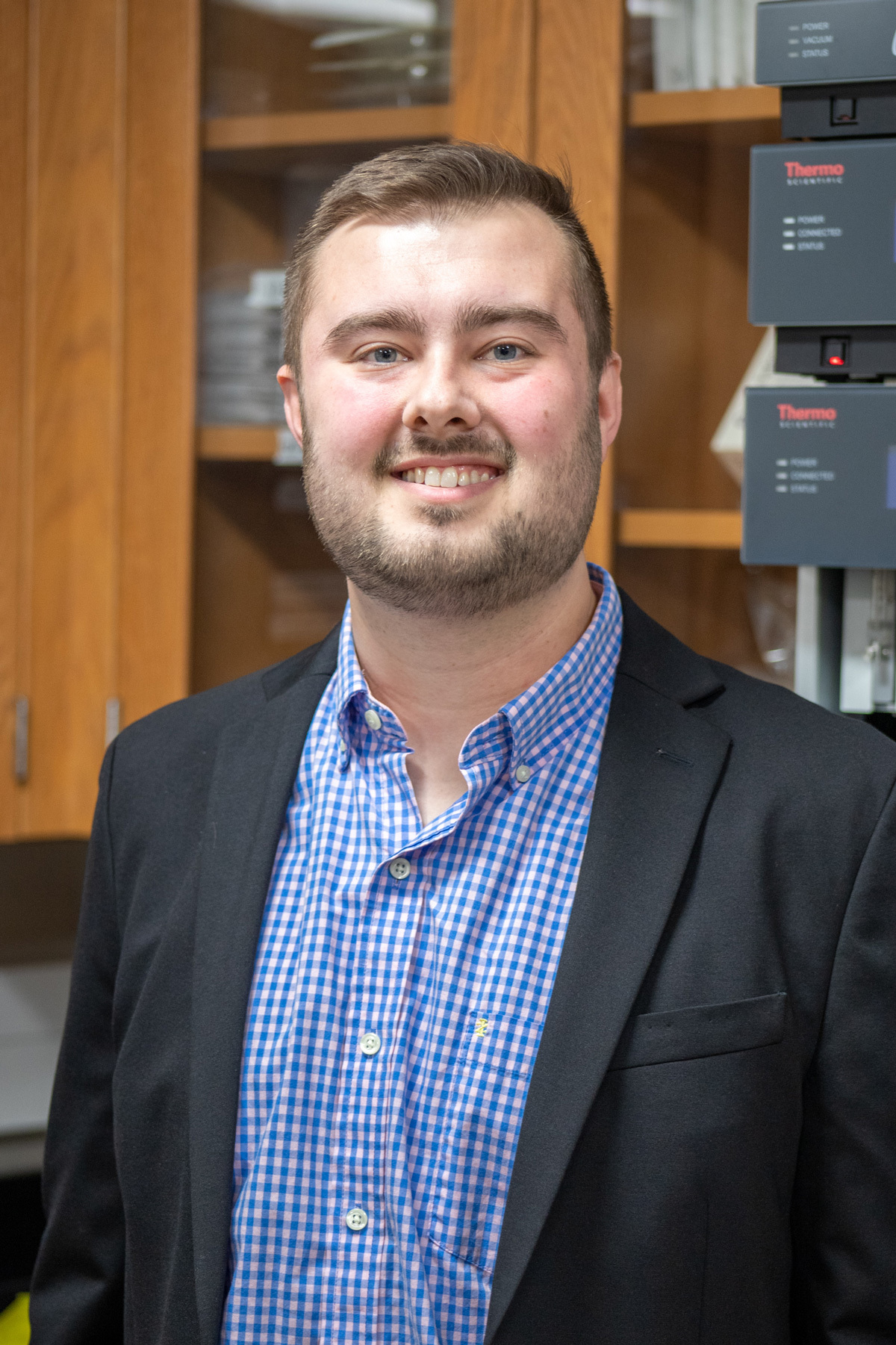
Camron Haas
The Biochemistry of Breweries: Targeting Biochemical Pathways to Prevent Beer Spoilage
Beer has been brewed for well over 4,000 years and humans have been perfecting the process all along the way. One problem that brewers still face is the development of off-flavors. Off-flavors are any specific flavor that does not fit with a particular style of beer. One common off-flavor that develops is a buttery taste. The cause of that off-flavor is a molecule called Diacetyl. Diacetyl is produced by yeast, but it enters the beer by leaving the yeast cell as the precursor molecule, α-Acetolactic acid (acetolactate). Breweries do reuse yeast cultures to some extent, however these cells only remain stable for a finite number of generations, after which a fresh culture must be used. This is because the yeast produce more diacetyl the 'older' they are, so the more batches that use the same yeast the more Diacetyl will be produced. This project will use an additive called acetolactate synthase inhibitor to control the production of Diacetyl. This inhibitor targets the production of Diacetyl's precursor molecule, acetolactate. This project will analyze the acetolactate synthase inhibitor's ability to lower the level of Diacetyl in beer. To accomplish this, an assay to detect levels of Diacetyl in beer will be created. This assay will then be used to compare the concentration of Diacetyl in beer that was fermented using yeast with the acetolactate synthase inhibitors vs. yeast that were not given any additives. It is expected that the yeast cells with the inhibitor should produce beer with less Diacetyl off-flavor as the additive blocks the synthesis of acetolactate in yeast. This could lead to significant cost reductions by requiring fewer fresh yeast cultures.
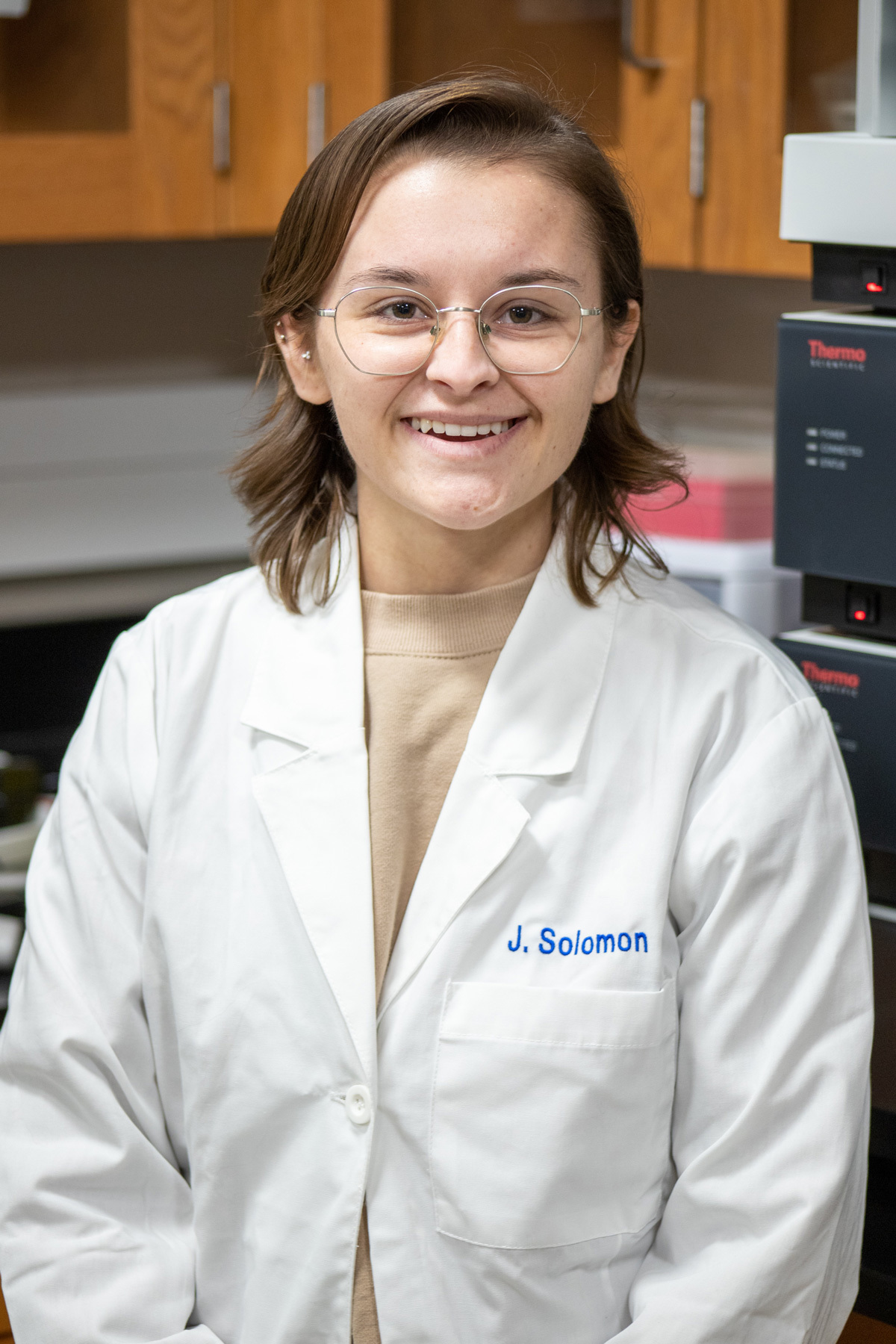
Juliann Solomon
Assessing the Effects of Bitter Melon on Diabetic Cardiac Fibrosis
Biotech Seniors 2021-2022

Allayah Stillwell
Natural Products as Anticancer Therapeutics: Analysis of the Anticancer Potency of EGCG, a component of Green Tea, on HCT 116 Colon Cancer Cells
Green tea has been used in Chinese medicinal culture as early as 2700 BCE. Green tea has a high abundance of catechins and other antioxidants, which potentially contribute to its purported health benefits. Many of green tea’s health benefits have been attributed to its main constituent, Epigallocatechin gallate (EGCG). Literature reveals that EGCG potentially binds to the 67LR receptor, which is overexpressed in some cancerous cells, presenting the potential for EGCG to be used as a treatment to inhibit cancer cell proliferation. In this project, several experimental questions will be explored regarding EGCG including: what concentration of EGCG is in commercial green teas, what is the expression-level of 67LR on HCT 116 cancer cells, what is the anticancer potency of EGCG, and characterization of EGCG’s membrane permeability. High Pressure Liquid Chromatography (HPLC) will be used to quantitate EGCG in green tea preparations. EGCG’s anticancer potency will be assessed by exposing HCT 116 cells to various concentrations of EGCG spiked into cell culture media for 48 hours. Cell viability will then be assessed using a in vitro assay (MTT) and flow cytometry. Cellular permeability will be assessed by treating cells with EGCG and then quantitating the intracellular accumulation of EGCG under different conditions. Overall, the results of this research project will contribute to our understanding of EGCG and its potential use as an anticancer therapeutic.

Sophia Khatri
Neurodegenerative Diseases: Assessing the Protective Effect of GABA on Neuronal Cell Lines (SH-sy5y and PC12) from MnCl-Induced Parkinson’s Disease
When people think of brain disorders one of the first ones that comes to mind is Alzheimer’s, however Parkinson’s Disease is just as prevalent. 60,000 Americans are diagnosed each year with Parkinson’s Disease and 10 million people worldwide are living with Parkinson’s Disease. Little is known about the specific mechanism of this disease; however, it has been shown that death and impairment of dopaminergic neurons occurs resulting in failure to communicate, therefore there is a loss of motor function as well as other cognitive disabilities. Common therapeutics include dopamine promoters, antidepressants, anti-tremor medication, and lifestyle changes. One common treatment, Levodopa, is a dopamine precursor that passes into the brain and is converted into dopamine. However, most of these treatments vary from person to person. Instead of a curative approach, these medications are used to relieve the symptoms and maintain the quality of life. Recently, researchers have evaluated alternative approaches to treat Parkinson’s Disease. GABA (Gamma aminobutyric Acid), a natural neurotransmitter in the brain, can potentially prevent damage to dopaminergic neurons. However, the mechanisms of GABA’s preventive abilities are still unknown. This work will assess GABA’s potential as a preventative against the effects of manganese chloride (MnCl2) in promoting Parkinson’s Disease progression in vitro. Neuronal cell lines, SH-sy5y and PC12, will be grown in culture and assessed using a western blot for their expression of GABA receptors, GABAa and GABAb. Once we have demonstrated expression of these receptors, we will expose the cells to MnCl2 which induces the cell impairment and death observed in Parkinson’s Disease. These same cells will then be cultured with MnCl2 + GABA to determine the effect of GABA on preventing this damage by observing cell morphology and cell viability. This research aims at showing an alternative and more natural treatment to Parkinson’s Disease by showing GABA’s potential neuroprotective effect on diseased cells.

Rylee Hanson
Immunology: Analyzing Jurkat T Cell Viability and T Cell Receptor Signaling in Acidic Microenvironments
The immune system plays a key role in our overall health. The immune system protects from foreign invaders such as viruses and bacteria, but it also protects from abnormal cell growth, such as cancer. Cancerous tumors form when healthy cells mutate in a way that dysregulates their growth and survival. If left unchecked, these abnormal cells can grow uncontrollably and begin to spread. One way that the immune system recognizes and destroys abnormal cells and invaders is through recognition by T cells. T cells recognize foreign antigens via their T Cell Receptors (TCRs) which have been randomized, generated, and then negatively selected against self-reactive recombinants. A sampling of all proteins made by the cell is presented to T Cells via major histocompatibility (MHC) proteins present on all nucleated cells. A successful interaction between a T Cell and an MHC bearing foreign peptide will initiate an immune response including TCR signaling and proliferation. Interestingly, cancerous tumors have been observed to have acidic microenvironments, meaning the area immediately surrounding the tumor tends to be acidic. Acidic environments can negatively impact proteins, potentially causing them to denature. One concern is that the acidic nature of the tumor microenvironment could negatively impact the interaction between the T Cell and MHC molecule thereby reducing the efficacy of an immune response. This work will use Jurkat T Cells as a model T Cell line to evaluate the survival, immune signaling, and proliferation of T Cells under differing pH environments. Understanding how T Cells respond when exposed to tumor microenvironments could lead to potential targets for cell modifications and advance cancer treatments to improve patient care.

Zachary Binkley
Cellular Pharmacology: Assessing Phenibut’s Inhibition of Calcium-induced Toxicity in U87MG cells, an in Vitro Model for Traumatic Brain Injury
In 2019, 61,000 traumatic brain injury (TBI) related deaths were reported in the United States. Those who survive severe head injury are often left with permanent damage that results in life-long depression, decreased cognition, decreased self-regulation, and increased propensity to neurodegenerative diseases. A large portion of the brain damage from TBIs comes from secondary damage when neighboring brain cells are killed by excessive extracellular glutamate and calcium ions, released by the physically damaged cells, which disrupts the homeostatic balance of intracellular calcium in bystander cells resulting in apoptosis. Without therapeutic intervention, the secondary damage is difficult to control and will progress for several days after initial trauma. Phenibut is a therapeutic associated with a decrease in the extent of secondary damage. Interestingly, phenibut is a derivative of Gamma-AminoButyric Acid (GABA), the body’s primary inhibitory neurotransmitter. Phenibut exhibits voltage dependent calcium channel blockade and GABA receptor agonism. Both mechanisms work to counter the toxic effects of excessive glutamate and calcium on brain cells. My research seeks to assess the efficacy of phenibut in preventing apoptosis in U87MG glioma cells exposed to varying concentrations of calcium and glutamate. Intracellular calcium will be measured with Rhod-4 calcium chelating fluorescent dye. Cell viability will be assessed with an MTT assay and flow cytometry. These data will further validate the potential for phenibut to prevent secondary damage from TBIs.

Jacob Freitag
Antimicrobial Biologics: Design and Characterization of Novel Iron Ion-Binding Peptides as Antimicrobial Agents
Yearly in the United States, over 1.7 million individuals are hospitalized with bacteremia (bacteria in the bloodstream) leading to long-term damage to organs and possible death. Treatment for bacteremia normally depends on extended use of antibiotics, yet increased usage of these compounds overall has contributed to antibiotic-resistant strains and the continued efficacy of these treatments is now in question. With approximately 270,000 deaths annually, the need for new antibiotics and novel co-therapies cannot be overstated. Iron ions specifically increase the proliferation rates of various pathogenic bacteria while simultaneously catalyzing the production of damaging reactive oxygenated species (ROS) within the host. Free iron ions in bacteremia patients’ serum correlates with an increased likelihood of multiple organ failure and death. Pairing these observations with ongoing research studying metal-binding peptides such as the Amino Terminal Copper and Nickel (ATCUN) motifs, which sequester metal ions in physiological environments, has confirmed these chelating agents as important adjuvants to traditional antibiotic treatments. This research is focused on discovering, building, and characterizing iron ion-binding peptide motifs (FBMs) that may be used in tandem with antibiotics and/or incorporated into new therapies such as anti-microbial peptides (AMPs). Development of FBMs will be done using a combination of bioinformatics and biomimetic design using natural iron-binding proteins as the model. The selected FBMs will then be produced by a AAPPTec Focus XC automated solid-phase peptide synthesizer using standard fluorenylmethyloxycarbonyl (Fmoc) chemistry. Once completed, characterization studies will evaluate the iron ion-chelating capacity of these FBMs and their anti-microbial potency against known iron ion-dependent opportunistic pathogens such as Escherichia Coli, and Pseudomonas Aeruginosa grown in vitro.

Paige Kramer
Natural Products & Immunology: Assessing the Effect of Rosemary Extract on Histamine Release in Stimulated Murine Mast Cells
Each year more than 50 million Americans suffer from allergies. These may be life-threatening food allergies, pet allergies, or common seasonal allergies. Mast Cells are the main proponent of allergic reactions, mediated by the process of degranulation. During this process, the cell expels its granules and releases various molecules including histamine, beta-hexosaminidase, and others. These initiate an immune response which can result in symptoms ranging from mild irritation to system-wide anaphylaxis. Whereas antihistamine treatments block the histamine signaling on bystander cells, no drug has been found to stop the activation of mast cells, which remain an alluring target. Recent work has shown that Rosemary Extract (RE) has the potential to prevent mast cell degranulation. This project addresses this possibility using murine peritoneal mast cells and extracts of rosemary. Rosemary will be organically extracted overnight and then filtered before its complexity is assessed using reverse phase HPLC. Murine peritoneal mast cells will be harvested from mouse peritoneal cavities, enumerated, and assayed for the ability of RE to ameliorate their degranulation in vitro. A combination of quinacrine staining, microscopy, and flow cytometry will be used to both confirm the identity of the mast cells and measure their degranulation. A beta-hexosaminidase assay will be used to quantify degranulation, with and without the addition of RE.

Amber Worden
Gene Therapy: Evaluating the Anticancer Effect of PTEN Gene Therapy on 4T1 Breast Cancer Cells
One in 8 women in the United States will develop breast cancer within their lifetime. Chemotherapy is a common therapeutic for cancer, however, its toxicity is not limited to cancer cells, leading to a number of debilitating side effects. Alternative therapeutics are being developed to spare healthy cells without sacrificing efficacy. One alternative is gene therapy, which works to recover expression of a lost gene in genetically diseased cells. This project will use a viral vector to mediate gene therapy to restore the expression of the tumor suppressor gene, PTEN. Prior work suggests that the recovery of normal PTEN expression in these cancer cells could lead to reduced proliferation and cell death. This project aims to explore gene therapy as a potential anticancer tool in 4T1 cells as a model. Specifically, Lenti-293T cells will be used to incorporate PTEN into lentiviral vectors that will be used to infect 4T1 cells and reincorporate the PTEN gene into their genome. Once incorporated, PTEN expression will be induced and PTEN expression levels and anticancer effect will be measured. Overall, this research will demonstrate the potential of restoring tumor suppressor genes as a form of effective gene therapy.
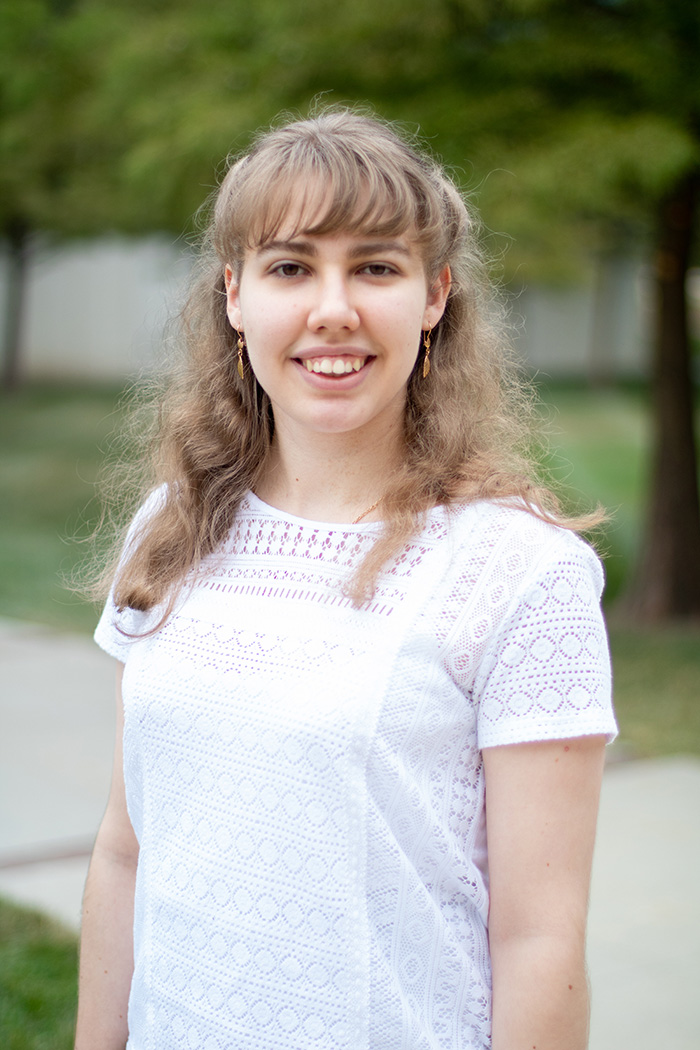
Valeria Laber
Cellular Pharmacology: Assessing the Impact of Ivermectin Treatment on Cell Viability and Microtubule Stability in Mammalian Cells Grown in vitro
The medical community and health officials have a serious concern about using the anti-parasitic worm medication, Ivermectin, for SARS-CoV-2 treatment. Several studies have shown Ivermectin to have antiviral action against Sars-CoV-2 in vitro; however, more work needs to be done to demonstrate the safety of this drug and investigate off-target effects. Despite the lack of such evidence, Ivermectin has been touted by some groups to be an effective treatment for Covid-19 resulting in 1,718 cases reported of exposure to Ivermectin from January 1, 2021 to October 17, 2021, according to the American Association of Poison Control Centers. It is therefore critical to establish a solid base of scientific evidence to support or refute the assertion made by these groups. Current evidence shows that Ivermectin acts against parasitic worms by binding to glutamate-gated chloride ion channels in invertebrate muscle and nerve cells of the microfilaria which increases influx of chloride ions into the cells and eventually causes death of the parasitic worm. In humans, Ivermectin can be used as a broad-spectrum anti-parasitic for the treatment of tropical parasites. However, mammals lack these ion channels and Ivermectin may bind to the microtubules of these cells and may adversely affect functions such as cellular proliferation. This research project aims to assess the potential adverse effects Ivermectin treatment can have on the cell viability and microtubule stability of mammalian cells (HeLa) grown in culture. Flow cytometry will be used to evaluate potential impacts on cell viability and cell cycle arrest. Cell viability (cell toxicity) will be assessed using an MTT assay. Additional work will focus on visualizing potential changes to intracellular microtubule structures by using fluorescent microscopy. The results of this research project should provide additional data to understand the effects of Ivermectin on microtubule proliferation.

Lucy Johnson
Natural Products & Immunology: Analyzing the Potential Blockading Effect of CBD Treatment on LPS-Mediated Inflammation
About 1.5 million Americans suffer from Rheumatoid Arthritis (RA), an autoimmune, chronic inflammatory disease with no cure. This is a condition in which the immune system mistakenly attacks healthy cells, leaving the body in a constant state of inflammation. A major characteristic of RA is unresolved inflammation specifically in the joints of the hands, wrists, and knees. People who have RA suffer from pain, experience bone and joint deformity, and exhibit a loss of function in the targeted areas. In these patients, the immune system is not working properly and the immune responses are unregulated. As an autoimmune disorder, B cells are presenting healthy cells with autoantigens that trigger multiple signaling pathways that lead to the release of cytokines. A primary cytokine, IL-6, plays a role in the pathogenesis of RA due to its pro-inflammatory effects. IL-6 causes the release of acute phase proteins which cause fevers, iron deficiency, fatigue, fat and muscle loss, anorexia, and weakness. IL-6 release, therefore, represents a key therapeutic target as this may prevent the initiation of inflammatory responses. Cannabidiol (CBD) has been shown to exert a number of pharmacological effects, including anti-inflammatory and antioxidant properties. Herein, I will determine whether CBD treatment can decrease IL-6 expression in inflamed cells. Cells will be stimulated with LPS which will model inflammation in vivo. Cells will be co-cultured with different amounts of CBD and the expression of IL-6 will be measured using western blot. The expected results of this experiment are that CBD decreases the expression of LPS induced IL-6.
Biotech Seniors 2020-2021

Alaina Coughlin
Biotherapeutics: Characterizing the impact IL-13 treatment has on mucus production of cultured human adenocarcinoma cells.
Every year between 30,000 and 40,000 people are newly diagnosed with ulcerative colitis (UC) in the United States. UC is the most prevalent disease in the category of inflammatory bowel disease (IBD), it is disruptive to life, painful, and in severe cases it can be deadly. UC is caused by a thinning of the mucus layers that protect the lining of the digestive system from enteric bacteria and other materials. Enteric bacteria are typically harmless and even beneficial, but with the absence of a mucus barrier they can infiltrate the lining of the digestive system and cause a severe immune reaction and ulceration. IL-13 is a protein used by the immune system primarily to regulate the response to parasites. However, it has also been implicated in other immune responses: the mediation of allergic inflammation and airway hyper-responsiveness in asthma. Recently, increased levels of IL-13 have been observed in severe cases of SARS-CoV-2. IL-13 regulates, among other responses, goblet cell metaplasia and subsequent mucus secretion. My research aims to observe the effects of IL-13 treatment on a simulated intestinal epithelium (HT29 cells grown in culture) and its ability to induce goblet cell metaplasia and enhancement of mucus production. This work could be the foundation for treatments of UC that address the root cause of the disease, rather than current treatments of long-term immunosuppressants.

Andy Cardona Orellana
Drug Metabolism & Pharmacokinetics: Assessing the influence glycosylation plays in protecting antibodies from lysosome-based proteolytic degradation.
Antibody therapeutics have recently become a valuable tool in the treatment of disease. Their ability to bind specifically to one target affords them exquisite selectivity, which can dramatically reduce off-target drug effects. Antibodies are important endogenous biomolecules that play a critical role in fighting disease. As such, our bodies have evolved mechanisms to protect antibodies from premature degradation and therefore tend to have highly favorable pharmacokinetic properties. Antibodies, such as IgG, can be taken up by cells such as monocytes, but are kept from lysosomal degradation by their interaction with the FcRn receptor. The FcRn receptor binds to the constant region of the IgG to protect them from degradation by exocytosing the IgG back into the serum. Studies have shown that glycans found in the constant region of IgG influence its interaction with the FcRn receptor. Therefore, the design of therapeutic antibodies must also consider lysosomal recycling pathways. Without the proper engagement of the FcRn, these therapeutics would have a greatly diminished half-life within the body, which would reduce their effectiveness. My research project aims to study the influence that glycosylation has on protecting IgG antibodies from lysosomal degradation in cultured THP-1 cells, a model for monocytes. Using fluorescent tags and live-cell dyes, I will evaluate the degree of antibody-lysosomal colocalization and assess proteolytic degradation of the antibodies using western blot analysis. These studies will compare results between antibodies with native glycosylation vs. deglycosylated antibodies. The results of this study will improve our understanding of antibody glycosylation and its influence in protecting them from proteolytic degradation.

Steve Harris
Neurodegenerative Diseases: Assessing the impact that variable expression of the SOD-1 protein has on the abundance of intracellular reactive oxidative species in cultured human cells.
Amyotrophic Lateral Sclerosis (ALS), though relatively rare, is a debilitating and fatal condition for which there currently is no cure. ALS is a degenerative neuromuscular disorder in which neural cells are damaged, leading to loss of function, and eventually affecting all muscles in the body. Mutation of the SOD-1 gene, a gene encoding a superoxide dismutase, has been identified as a significant contributor to the debilitating effects of ALS. Dysfunction of the SOD-1 gene can lead to a toxic, free radical-ladened environment inside neural cells leading to cell damage and death. This study aims to determine the influence variable expression levels of the SOD-1 enzyme have on the intracellular abundance of free radicals in human cells. To test this, HeLa cells will be used as a model human cell line in which we will vary SOD-1 expression levels: unmodified wild-type HeLa cells representing normal SOD-1 expression, HeLa cells overexpressing SOD-1 (via a transient transfection), and HeLa cells under-expressing SOD-1 (via an siRNA knock-down). The abundance of intracellular free radicals will be assessed using a fluorescent reporter system in a microplate assay format and fluorescence micrograph format. These results are expected to strengthen our understanding of the relationship between SOD-1 expression and its role in mitigating the intracellular abundance of free radicals in human cells. This knowledge could guide therapies to counter the debilitating effects of ALS and improve quality of life for these patients.

Jackson Cobb
Pharmacogenomics: Assessing the genotype-phenotype relationship of the drug metabolizing enzyme CYP1A2 allele A vs allele C on caffeine metabolism in a human subject.
Caffeine is the world's most widely consumed psychoactive drug. Caffeine can be found in food, drinks, and supplements. Many of us ingest caffeine every day to wake up for the day or throughout the day as an energy supplement. Some individuals can consume a large amount of caffeine on a daily basis but not suffer the negative consequences of insomnia despite the stimulant effects of the drug, while others experience these adverse effects even with only moderate amounts of caffeine. In large part, this is attributable to the enzyme responsible for breaking caffeine down, CYP1A2. Furthermore, it has shown that there is a link between increased risk of cardiac arrest depending on which variant of CYP1A2 with the consumption of caffeine. The human population exhibits a wide variability in the genetic sequence for drug-metabolizing enzymes (i.e., genotype) that can lead to alterations in the body’s ability to remove the drug from the body (i.e., observed phenotype). Understanding this relationship is critical for scientists seeking to characterize drug dosages for the human population. My research seeks to characterize a genotype-phenotype relationship in a human subject using caffeine as a model drug. To accomplish this goal, I will identify the genotype of the subject by PCR across a variable region of the enzyme involved in caffeine metabolism (genes: CYP1A2 AA/C and enzyme CYP1A2). To identify the phenotype, I will design a quantitative method using HPLC to perform a PK study and determine drug half-life. These data sets will be combined to assess the individual’s genotype and phenotype relationship.

Suzie Zell
Nutraceuticals: Assessing the antimicrobial potency and chemical composition of oregano essential oil: A scientific approach to test a supplement company’s therapeutic claim.
The increased prevalence of antibiotic-resistant bacteria has generated growing interest in alternative/accessory antimicrobial agents. To meet this demand, many supplement companies market “essential oils” which are concentrated extracts from plants. These companies claim that their marketed essential oils have many health promoting properties such as antibacterial, antifungal, and anti-inflammatory effects, among others. My research aims to study the antimicrobial potency of oregano essential oil on Staphylococcus epidermis, Escherichia coli, Pseudomonas aeruginosa, and Candida albicans. Additionally, we will specifically evaluate the antimicrobial potency of carvacrol, a compound found in high concentrations within the essential oil and suspected to be its active ingredient. Using the optical density at 600nm, this study will characterize the growth vs time curves of the selected microbes to determine the antimicrobial potency of the essential oil and carvacrol. Using HPLC, we will also measure the endogenous concentration of carvacrol within the essential oil. The results of this study will allow an evidence-based approach to scientifically evaluate the supplement company’s claim that their oregano oil possesses antibacterial and antifungal properties. Overall, this work serves as a standard by which supplement companies can make a claim regarding the antibiotic activity of this and other similar nutraceuticals.

Sydney Isabelle
Pharmacognosy: Assessing the anticancer potency and selectivity of mushroom-extracts in model cell culture-based systems.
Fungi are everywhere. They are in your food, in your house and even in your body. Fungi are neither plant nor animal but a kingdom all their own. Over time, people have found increasingly creative ways to exploit the many uses of fungi. Throughout history, fungi have been used as a food source, a tool to enhance biodegradation of organic material and as a medicine. As they relates to medicine, mushrooms have been reported to contain compounds that exhibit powerful anticancer activity. To evaluate these claims, these compounds will be extracted from the mushrooms using solvents such as water or methanol and then tested on the cervical carcinoma cells line, HeLa, grown in culture. If the extracts show anticancer activity, further downstream purification will be performed to identify the specific active components. This project focuses on extracting hydrophobic compounds from different species of mushrooms, examining their chemical fingerprint, and testing their anticancer potency and selectivity in model cell culture-based systems.

Richard T. Oliver
Aging Research: Assessing the influence CSB, a gene associated with premature aging in Cockayne syndrome, has on the induction of premature cellular senescence in a model cell culture-based system.
Cockayne Syndrome (CS) is a rare, fatal condition characterized by cognitive delays, stunted growth, and precocious aging. The molecular basis of CS is a disorder of the ERCC6 gene which codes for protein, CSA, involved in DNA repair. The accumulation of DNA damage over time contributes to cellular senescence and premature aging. Cellular senescence, defined as the irreversible arrest of cell proliferation following oncogenic stress such as DNA damage, is thought to be a major contributor to aging. The gold standard biomarker for measuring senescence is the hydrolysis of beta-galactosides into monosaccharides, which occurs only in senescent cells. My research aims to explore the influence that the CSB protein has on controlling senescence in human cells grown in culture. CRISPR will be used to knock out the ERCC6 gene in HeLa cells and verified by confirmation by PCR. To characterize any subsequent transformation of cells to a senescent phenotype, a beta-galactosidase activity assay will be developed using Fluorescein di(β-D-galactopyranoside), a fluorescent substrate for Senescent-Associated Beta-Galactosidase activity. The results of this study will further our understanding of the link between precocious aging-related disease states, cellular senescence, and the role of the CSB protein.

Emily Munden
Antiviral Therapies (Coronavirus): Evaluating the in vitro safety and potential antiviral activity of chloroquine and ivermectin on cultured human lung cells infected with coronavirus.
The outbreak of SARS-CoV-2 in 2019-2020 has resulted in a global pandemic infecting millions of people worldwide. As cases continue to surge and death rates climb, the race to find safe and effective coronavirus therapies is more important than ever. The mechanisms of infection and proliferation of coronavirus have been thoroughly studied and this knowledge can be exploited to develop therapeutics to potentially treat those infected with the virus. In previous studies, chloroquine has been shown to disrupt endocytosis and exocytosis processes involved in coronavirus infection, while ivermectin has been shown to inhibit coronavirus’ effect on the host cell’s anti-viral response. This research study examines chloroquine’s and ivermectin’s potential to inhibit coronavirus proliferation in a model human cell line grown in culture. Specifically, this study evaluates the in vitro safety, time- and dose-dependent anti-viral activity of these drugs, and the potential for synergic effects that might enhance antiviral activity of these two drugs. While the world continues to race for effective treatments and potential cures for SARS-CoV-2, the data collected in this study could provide insight into chloroquine’s and ivermectin’s potential to disrupt coronavirus infection.

Maya Abuhijleh
Forensic Science: Employing short tandem repeat (STR) analysis to develop a cheap and reliable assay to verify human cell lines.
Over the years, DNA analysis has vastly increased the power of forensics, and has become an invaluable tool in law enforcement. DNA evidence is key to linking suspects to various crimes such as robbery, rape, murder, as well as serving as a tool for paternity testing and disease screening. However, these technologies are also applicable to questions outside of forensics. One such question arises in the laboratory when researchers are culturing a number of different cell types in close proximity. Because many cell types can look the same microscopically, it becomes possible to confuse, mislabel, or even cross-contaminate cell cultures. This research project aims to develop an assay that utilizes short tandem repeat (STR) analysis as a tool to verify human cell lines grown in culture in an affordable and reliable fashion. A small number of STRs will be analyzed by polymerase chain reaction to produce DNA products of variable sizes, as determined by the cell’s alleles, which will make up a fingerprint identifying each of several cell types. As these are human STRs, they can also be used to identify human DNA samples, which will further demonstrate the flexibility and reliability this test.
Biotech Seniors 2019 - 2020

Zachary Mock
Cancer Therapy: Is Ellagic Acid, a micronutrient found in fruits a vegetables, a cancer fighting agent?
Ellagic Acid is a micronutrient found in fruits and vegetables, described as a polyphenol antioxidant, with a purported ability to induce apoptosis and reduce cellular proliferation of cancer cells. My capstone project is focused on assessing the anticancer potency of Ellagic Acid. My research will characterize Ellagic Acid’s cytotoxic potency and antiproliferative effects on a cervical cancer cell line, HeLa. Additionally, I seek to determine the natural abundance of Ellagic Acid in select fruits and beverages. Ultimately, this research could provide evidence that supports further investigation into Ellagic Acid’s potential as a cancer fighting therapy.

Jerod Vandervort
Animal Health: Is CBD an effective therapeutic treatment for reducing anxiety in dogs?
Like humans, many dogs suffer from debilitating anxiety. Recent hype surrounding cannabidiol (CBD) and its therapeutic potential for treating anxiety has inspired me to design a study to test this claim. My research focuses on developing an assay capable of detecting cortisol, a physiological biomarker of stress/anxiety, in the saliva of dogs. Once this assay is validated, a single-animal crossover study will be performed in which baseline values of anxiety will be assessed using both observational data and quantitative cortisol levels found in saliva. Following baseline assessment of anxiety, a veterinarian-prescribed regimen of CBD will be administered and assessment of anxiety will continue to the end of the study. Ultimately, this data could provide evidence to support further investigation into CBD as a routine and effective treatment for managing anxiety in canines.

Kevin Long
Cancer Therapy: Can the sweet drinks we enjoy also fight cancer?
Sweeteners are commonly added to our food and drinks. What if some of these sweeteners also had cancer-fighting properties? Monk fruit is a common sweetener that naturally contains mogroside V which has been suggested to have anticancer properties. Although mogroside V’s mechanism of action is not fully understood, it is thought to limit cancer cell growth by increase the expression of p53, a tumor suppressor. My capstone project aims to measure two key aspects of mogroside V’s impact on a cervical cancer cell line (HeLa): its cytotoxic potency and its impact on p53 expression-levels. Ultimately, this research will provide evidence to support further investigation into mogroside V and its potential to serve as an anticancer therapy.

Kristi Lin
Environmental Biology:Induction of Escherichia Coli (E. Coli) to Degrade PET Plastic, an environmental pollutant.
Accumulation of plastic waste in our natural environment is becoming a serious threat to wildlife and the health of Earth’s ecosystems. Plastics accumulate in our environment because there are limited number of organisms capable of degrading them, i.e., they are not biodegradable. Until recently, scientists were not aware of an existing natural mechanism capable of biodegrading plastics. However, a strain of bacteria was recently discovered that shows the ability to degrade polyethylene terephthalate, or PET plastic. These bacteria, named Ideonella sakaiensis (I. Sakaiensis), were found in sediments near a plastic bottle recycling facility in Sakai, Japan. Although I. Sakaiensis biodegrades PET plastic, it does so rather slowly and is only found in sediment and is therefore cannot effectively be used to degrade all plastic pollution. My project aims to exploit the genes I. Sakaiensis uses to degrade PET and insert these genes into Echerichia coli (E. Coli). Once established, these modified E. Coli could potentially be used as a tool to remediate environments polluted with plastics.

Justin Carroll
Vaccine Production: Can a toxoid-vaccine for strep throat be created from s. pyogenes toxin?
Streptococcus pyogenes is an extremely morbid bacteria, causing over 10 known diseases in humans including strep throat. A common mediator of the diseases caused by this organism is the toxin, streptolysin O. Streptolysin O is a protein secreted by streptococcal bacteria capable of directly injuring host cells and lysing red blood cells. Although widely researched, there remains no vaccine against s. pyogenes. My research aims to clone this toxin and inactivate it in order to generate a safe and effective vaccine.
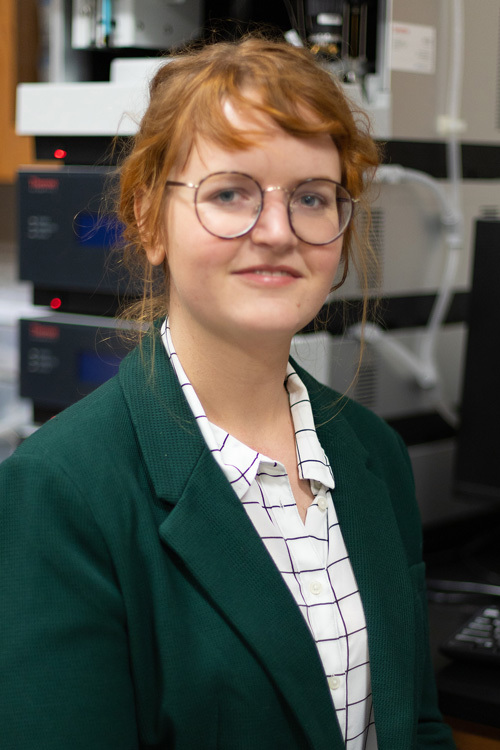
Darci Ezell
Drug Delivery: Development and testing of novel peptides to improve drug deliver to the brain
Diseases of the brain can be difficult to treat with pharmaceuticals due to a unique anatomical barrier called the blood brain barrier (BBB). The BBB is a collection of cells that encapsulates all the capillaries entering the brain. These cells are bound together by special proteins called VE-cadherins. VE-cadherins keep the cells of the BBB tightly linked and this limits drugs’ ability to slip into the brain. One promising method of increasing drug delivery through the BBB is by modulating (reducing) the tight binding of VE-cadherins. My research seeks to test two linear peptides’ (AVAIDK and KVFRVDAETGDVFAI) ability to modulate VE-cadherin binding and thereby increase drug penetration into the brain. VE-cadherin binding will be assessed using native PAGE (polyacrylamide gel electrophoresis). While changes in endothelial cell permeability will be observed by measuring TEER (trans-electrical endothelial resistance) values. Ultimately, this work will lay the foundation for follow-up work focused on developing adjunct therapies that improve the efficacy of brain-targeting drugs.
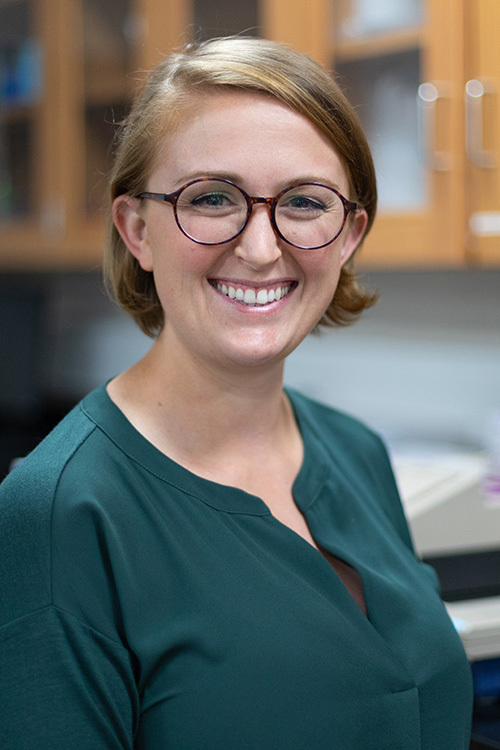
Claire Renfro
Immunology: Cloning and characterization of an immune signaling protein
When the immune system turns against itself, a variety of disease states arise. Many of these conditions exhibit a vicious cycle leading to increased severity of symptoms. In the last two decades, a new class of immune cells has been characterized as secreting a powerful signaling protein. These cells and the protein they secrete, interleukin – 17 (IL-17), have been linked to inflammation associated with the pathogenesis of autoimmune diseases, including the skin condition, psoriasis. In order to better understand the pathology of psoriasis, my research seeks to clone and characterize IL-17 and the signals it elicits in receptive cells.
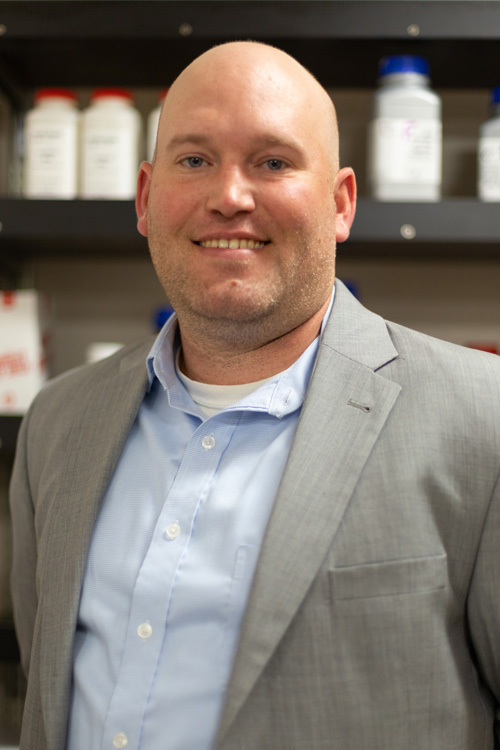
Patrick McDougall
Environmental Survey: Development and validation of a rapid, onsite test-kit to detect toxic algal blooms in local bodies of water.
Harmful algal blooms (HAB) are a growing concern for water supplies in the United States and around the world. These HABs are increasing in prevalence and produce toxins that negatively impact the health of humans, pets, livestock, and wildlife. Currently, there is not a wide selection of cost-efficient, on-site methods for testing water samples for HAB toxins. My research focuses on creating a simple test kit that can detect one of Kansas City’s most prevalent HAB toxins, microcystin. The design of the test-kit will exploit the natural inhibitory effects of microcystin on protein phosphatases to create a colorimetric assay that will generates signal proportional to microcystin concentration. This kit will enable users to perform a quick, on-site test of water supplies and determine if local bodies of water are contaminated with microcystin. Ultimately, this research will provide a proof of concept study that can potentially be used to launch a startup company focused on developing test-kits for public use.

Josue Bernal
Drug Delivery: Overcoming drug delivery barriers through the use of liposomes
Drugs can only be effective if they are able to reach their intended drug target. To reach these drug targets, they must traverse biological environments. Unfortunately, these environments present many anatomical and chemical barriers that limit drugs’ access to their intended target. Liposomes are tiny lipid-containing particles that hold the promise of overcoming many drug-delivery barriers. My project focuses on producing a variety of liposomes using different formulations and then testing their effectiveness of overcoming an antibiotic drug’s limited cellular permeability. This research project will lay the foundation for me as a scientist entering the scientific field of drug delivery.
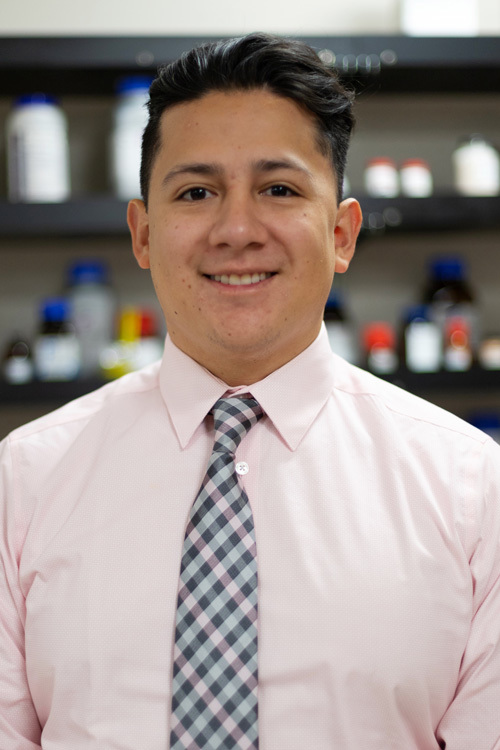
Kenny Escobar
Pharmaceutical Science: Are nutraceuticals truly what they say they are?
A nutraceutical is a food, fortified food, or supplement that is purported to provide medical benefits, boost performance, or prevent/treat disease. Nutraceuticals are available over the counter and do not require any medical supervision or oversight to use. Additionally, nutraceuticals often make audacious claims that “suggest” a myriad of health benefits resulting from the active ingredient; however, the Food and Drug Administration (FDA) does not oversee the production and safety of these products. This ultimately creates a situation whereby nutraceutical company’s can sell a product without actually proving the active component is present or proving the active component is present at the stated concentration. My research project is focused on analyzing glutamine supplements, testing for both the presence and abundance of glutamine and comparing that to the specifications defined on the packaging. This project ultimately aims to raise awareness of regulatory compliance of pharmaceuticals and their role in our society.
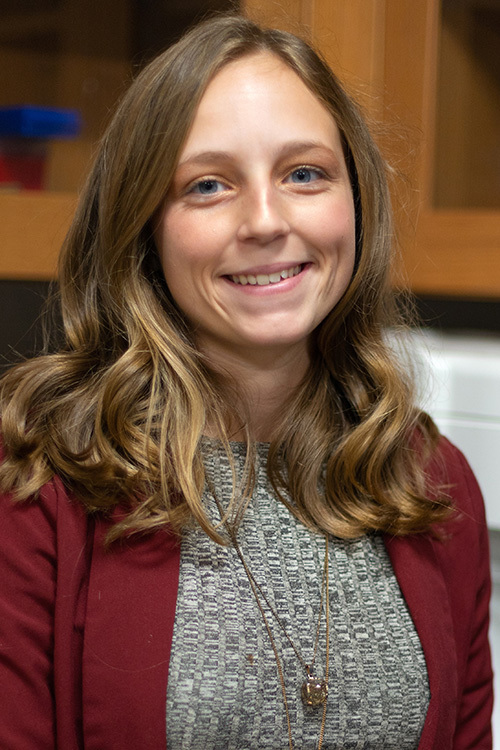
Cheyenne Smith
Stem Cell Therapy: Can insulin-producing cells be generated to treat diabetes in dogs?
Is the time for daily insulin injections for the treatment of diabetes coming to an end? Everyday thousands of pets are subjected to insulin injections to treat their diabetes. This puts a major strain on both the animals and their owners. I have the privilege to collaborate with Likarda, an animal health company seeking to find a better treatment for type 1 diabetes in companion animals. Our goal is to develop and optimize an effective and cost-efficient way of transforming stem cells into insulin producing cells that can be stably infused into animals. My project specifically examines the growth signals required to generate these cells in culture. Ultimately, this would serve as a long-term treatment for animals suffering from diabetes and thus eliminate the need for daily injections.
Biotech Seniors 2018 - 2019

Nancy Varela-Gastelum
Cancer Biology: Human cancer cells metabolize sugar in an aberrant way. Can this be reversed to remediate the cancer?
Cancer cells can display an array of aberrant cellular behaviors. One of these behaviors, termed the Warburg Effect, describes cancer cells that overproduce lactate through anaerobic metabolism. My research aims to design and validate a lactate quantitation assay. This assay will be used to characterize the Warburg Effect in various cancer cell lines. Additional studies will be performed to reduce the expression of Lactate Dehydrogenous, a key enzyme that produces lactate, and assess the antiproliferative effects of this modification. Ultimately, this lactate quantification assay could potentially be used by other cancer research labs to characterize metabolism of their cultured cells in an inexpensive way.

Austin Brewer
Cancer Therapy: Is Lychee fruit a cancer-slaying super food?
My project involves utilizing an extract, called kuromanin, from lychee fruit to treat breast cancer cells. The treatments have shown promise in other studies and I would like to build on those by not only testing extracts made from fresh fruit, but by also testing extracts from frozen and canned lychee because they are more widely available. From this project I hope to further investigate whether or not kuromanin could be used as a viable treatment for cancer in the future.
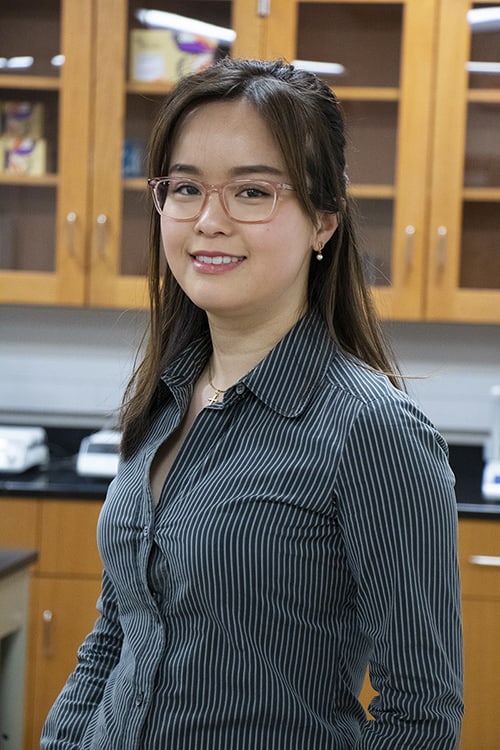
Phuong Dinh
Antibiotic Resistance: Does Manuka Honey contain our next-generation antibiotic?
Concerns have grown rapidly about antibiotic resistance in the recent years. Scientists are working to create and discover novel antibiotic drugs to combat this resistance. My project focuses on this area of scientific inquiry. Specifically, I am fascinated by the potential antimicrobial ability of honeys, especially Manuka honey. Methylglyoxal is the major antimicrobial component found in Manuka Honey. In my project, I am going to use the Kirby-Bauer method and microbial viability assays to measure the antimicrobial effects of Methylglyoxal against gram-positive, gram-negative and multidrug-resistant bacterial strains.
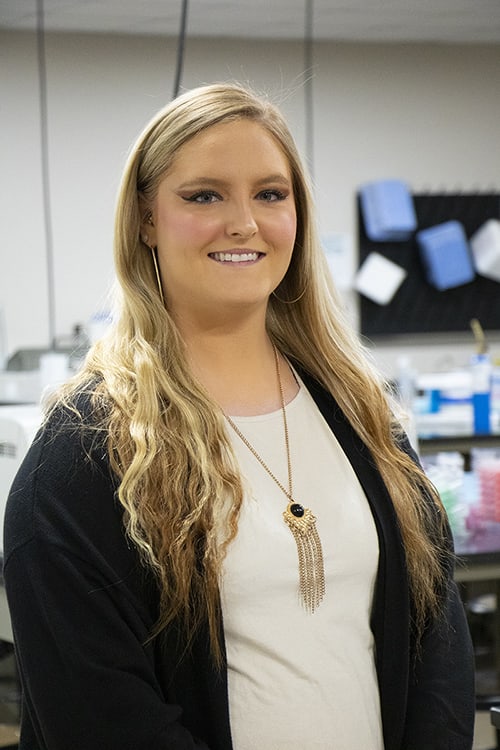
Aldyn Wildey
Drug Delivery: Can that diet soda really affect your brain? An in vitro study of aspartame permeability across the blood-brain barrier.
My capstone focuses on the design and validation of an in vitro blood-brain barrier assay. I would like to see if aspartame can pass through the blood-brain barrier using the neutral amino acid transporter (NAAT), which is expressed in the hCMEC/D3 human endothelial blood-brain barrier cell line. I will use high pressure liquid chromatography (HPLC) to measure the permeability of the aspartame into the brain in vitro.
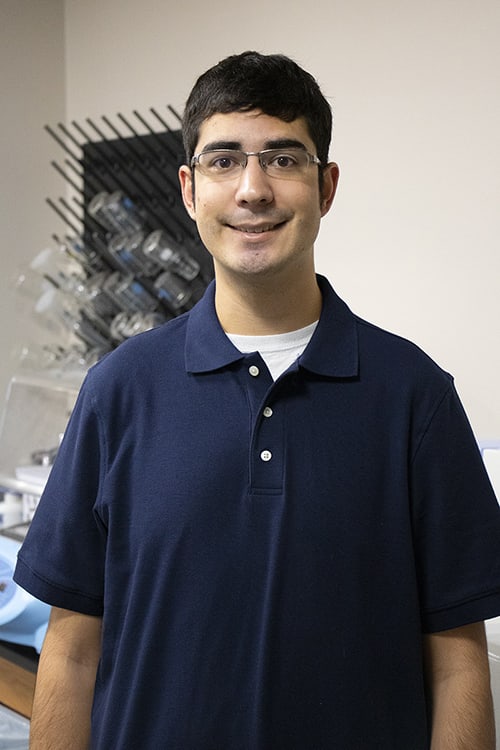
Alex Fowler
Gene Editing: Using CRISPR to make bacteria glow
I am doing my project on gene editing. Specifically, I will be using CRISPR-Cas9, a gene-editing tool derived from bacteria, to incorporate a fluorescence gene (GFP) into a specific region of the E. Coli genome. This experimental work will serve as a training experience as I seek to master the CRISPR-Cas9 tool. My follow-up studies will use CRISPR-Cas9 to specifically edit a gene within mammalian cells grown in culture.

Paniz Borzoofard
Disease Biomarkers: Creating an in-home test for PSA, a protein correlated with prostate cancer
PSA (prostate-specific antigen) is used as a biomarker to screen for prostate cancer in men. For my project, I want to develop an at-home test strip to assess PSA levels. The test strip will be designed to detect blood levels of PSA that exceed 3 ng/mL (the established threshold for a positive result in clinical testing). The broader goal of this project is to make it easier and cheaper for men to screen for prostate cancer. The increased ease and accessibility of this at-home test will hopefully decrease the number of deaths caused from delayed clinical testing.